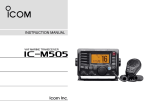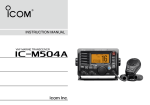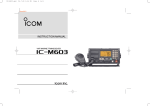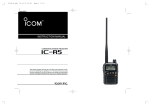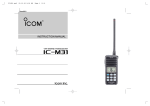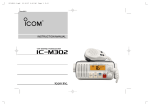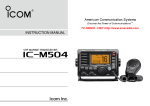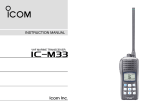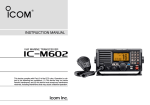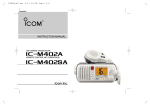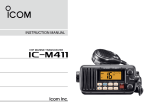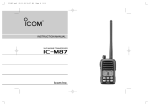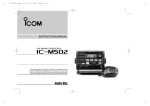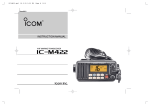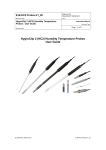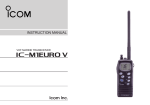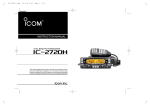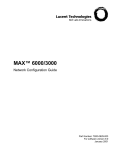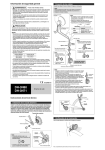Download IC-M505 Instruction Manual
Transcript
!IC-M505.qxd 06.3.28 2:57 PM Page A (1,1) New2001 INSTRUCTION MANUAL VHF MARINE TRANSCEIVER iM505 !IC-M505.qxd 06.3.28 2:57 PM Page i (1,1) New2001 FOREWORD IMPORTANT Thank you for purchasing this Icom product. The IC-M505 VHF MARINE TRANSCEIVER is designed and built with Icom’s state of the art technology and craftsmanship. With proper care, this product should provide you with years of troublefree operation. READ ALL INSTRUCTIONS carefully and completely We want to take a couple of moments of your time to thank you for making the IC-M505 your radio of choice, and hope you agree with Icom’s philosophy of “technology first.” Many hours of research and development went into the design of your IC-M505. D FEATURES ❍ Simple operation with large keys ❍ Easy to hear speaker ❍ Built-in DSC meets ITU Class D requirement before using the transceiver. SAVE THIS INSTRUCTION MANUAL — This instruction manual contains important operating instructions for the IC-M505. EXPLICIT DEFINITIONS WORD DEFINITION Personal injury, fire hazard or electric shock R WARNING! may occur. CAUTION NOTE Equipment damage may occur. Recommended for optimum use. No risk of personal injury, fire or electric shock. ❍ Rugged waterproof construction ❍ Optional COMMANDMIC III™ (HM-162E) is available Icom, Icom Inc. and the logo are registered trademarks of Icom Incorporated (Japan) in the United States, the United Kingdom, Germany, France, Spain, Russia and/or other countries. COMMANDMIC III is a trademark of Icom Incorporated (Japan) in the United States. i CLEAN THE TRANSCEIVER AND MICROPHONE THOROUGHLY WITH FRESH WATER after exposure to water including salt, otherwise, the keys and switch may become inoperable due to salt crystallization. !IC-M505.qxd 06.3.28 2:57 PM Page ii (1,1) New2001 IN CASE OF EMERGENCY INSTALLATION NOTE If your vessel requires assistance, contact other vessels and the Coast Guard by sending a Distress call on Channel 16. The installation of this equipment should be made in such a manner as to respect the EC recommended electromagnetic field exposure limits (1999/519/EC). USING CHANNEL 16 DISTRESS CALL PROCEDURE 1. “MAYDAY MAYDAY MAYDAY.” 2. “THIS IS ...............” (name of vessel). 3. Say your call sign or other indication of the vessel (AND 9-digit DSC ID if you have one). 4. “LOCATED AT ...............” (your position). 5. State the nature of the distress and assistance required. 6. Give any other information which might facilitate the rescue. Or, transmit your Distress call using digital selective calling on Channel 70. USING DIGITAL SELECTIVE CALLING (Ch 70) DISTRESS CALL PROCEDURE 1. While lifting up the key cover, push and hold [DISTRESS] for 5 sec. until you hear 5 short beeps change to one long beep. 2. Wait for an acknowledgment on Channel 70 from a coast station. • After the acknowledgement is received, Channel 16 is automatically selected. The maximum RF power available from this device is 25 watts. The antenna should be installed as high as possible for maximum efficiency and that this installation height should be at least 5 meters above ground (or accessible) level. In the case where an antenna cannot be installed at a reasonable height, then the transmitter should neither be continuously operated for long periods if any person is within 5 meters of the antenna, nor operated at all if any person is touching the antenna. In all cases any possible risk depends on the transmitter being activated for long periods. (actual recommendation limits are specified as an average of 6 minutes) Normally the transmitter is not active for long periods of time. Some radio licenses will require that a timer circuit automatically cuts the transmitter after 1–2 minutes etc. Similarly some types of transmitter, SSB, CW, AM, etc. have a lower ‘average’ output power and the perceived risk is even lower. 3. Push and hold [PTT], then transmit the appropriate information as listed above. ii !IC-M505.qxd 06.3.28 2:57 PM Page iii (1,1) New2001 DOC This warning symbol indicates that this equipment operates in non-harmonised frequency bands and/or may be subject to licensing conditions in the country of use. Be sure to check that you have the correct version of this radio or the correct programming of this radio, to comply with national licensing requirement. CE versions of the IC-M505 which display the “CE” symbol on the serial number seal, comply with the essential requirements of the European Radio and Telecommunication Terminal Directive 1999/5/EC. DECLARATION OF CONFORMITY We Icom Inc. Japan 1-1-32, Kamiminami, Hirano-ku Osaka 547-0003, Japan Declare on our sole responsibility that this equipment complies with the essential requirements of the Radio and Telecommunications Terminal Equipment Directive, 1999/5/EC, and that any applicable Essential Test Suite measurements have been performed. Kind of equipment: VHF MARINE TRANSCEIVER Type-designation: iM505 Version (where applicable): 0560 28th Feb. 2006 Place and date of issue Authorized representative name This compliances is based on conformity with the following harmonised standards, specifications or documents: i) EN 301 025-2 V1.2.1 (2004-09) ii) EN 301 025-3 V1.2.1 (2004-09) iii) EN 60945 2002 iv) EN 60950-1 2001 v) EN 300 698-2 V1.1.1 ( 2000-08) vi) EN 300 698-3 V1.1.1 ( 2001-05) Signature iii !IC-M505.qxd 06.3.28 2:57 PM Page iv (1,1) New2001 TABLE OF CONTENTS FOREWORD …………………………………………………………… i IMPORTANT …………………………………………………………… i EXPLICIT DEFINITIONS ……………………………………………… i IN CASE OF EMERGENCY…………………………………………… ii INSTALLATION NOTE ………………………………………………… ii DOC …………………………………………………………………… iii TABLE OF CONTENTS ……………………………………………… iv PRECAUTIONS ………………………………………………………… v 1 OPERATING RULES ……………………………………………… 1 2 PANEL DESCRIPTION ………………………………………… 2–5 ■ Front panel ……………………………………………………… 2 ■ Function display ………………………………………………… 4 ■ Microphone ……………………………………………………… 5 3 BASIC OPERATION…………………………………………… 6–11 ■ Channel selection ……………………………………………… 6 ■ Receiving and transmitting ……………………………………… 8 ■ Call channel programming ……………………………………… 9 ■ Channel comments …………………………………………… 10 ■ Microphone Lock function …………………………………… 10 ■ Display backlight ……………………………………………… 10 ■ Optional voice scrambler operation ………………………… 11 4 SCAN OPERATION ………………………………………… 12–13 ■ Scan types ……………………………………………………… 12 ■ Setting TAG channels ………………………………………… 13 ■ Starting a scan ………………………………………………… 13 5 DUALWATCH/TRI-WATCH ……………………………………… 14 ■ Description ……………………………………………………… 14 ■ Operation ……………………………………………………… 14 6 DSC OPERATION …………………………………………… 15–49 ■ MMSI code programming ……………………………………… 15 ■ MMSI code check ……………………………………………… 16 ■ DSC address ID ………………………………………………… 17 ■ Position and time programming ……………………………… 21 ■ Position and time indication …………………………………… 22 ■ GPS information indication …………………………………… 22 ■ Distress call …………………………………………………… 23 ■ Transmitting DSC calls ………………………………………… 26 ■ Receiving DSC calls …………………………………………… 41 ■ Received messages …………………………………………… 45 ■ DSC Set mode ………………………………………………… 47 7 OTHER FUNCTIONS………………………………………… 50–54 ■ Intercom operation …………………………………………… 50 ■ RX Speaker function …………………………………………… 51 ■ Hailer operation ………………………………………………… 52 ■ Automatic foghorn function …………………………………… 53 8 SET MODE …………………………………………………… 55–57 ■ Set mode programming ……………………………………… 55 ■ Set mode items ………………………………………………… 55 9 CONNECTIONS AND MAINTENANCE …………………… 58–64 ■ Connections …………………………………………………… 58 ■ Antenna ………………………………………………………… 59 ■ Fuse replacement ……………………………………………… 59 ■ Supplied accessories ………………………………………… 59 ■ Microphone hanger …………………………………………… 59 ■ Mounting the transceiver ……………………………………… 60 ■ MB-75 installation ……………………………………………… 61 ■ UT-112/UT-98 installation ……………………………………… 62 ■ HM-162E installation …………………………………………… 63 10 TROUBLESHOOTING …………………………………………… 66 11 SPECIFICATIONS AND OPTIONS ……………………… 67–68 ■ Specifications …………………………………………………… 67 ■ Options ………………………………………………………… 68 12 CHANNEL LIST ……………………………………………… 69–70 TEMPLATE 1 2 3 4 5 6 7 8 9 10 11 12 iv PRECAUTIONS RWARNING! NEVER connect the transceiver to an AC BE CAREFUL! The transceiver rear panel will become outlet. This may pose a fire hazard or result in an electric shock. hot when operating continuously for long periods. Place the transceiver in a secure place to avoid inadvertent use by children. NEVER connect the transceiver to a power source of more than 16 V DC or use reverse polarity. This will ruin the transceiver. NEVER cut the DC power cable between the DC plug at the back of the transceiver and fuse holder. If an incorrect connection is made after cutting, the transceiver may be damaged. NEVER place the transceiver where normal operation of the vessel may be hindered or where it could cause bodily injury. KEEP the transceiver at least 1 m away from the ship’s navigation compass. DO NOT use or place the transceiver in areas with temperatures below –20°C or above +60°C or, in areas subject to direct sunlight, such as the dashboard. AVOID the use of chemical agents such as benzine or alcohol when cleaning, as they may damage the transceiver surfaces. If the transceiver becomes dusty or dirty, wipe it clean with a soft, dry cloth. v BE CAREFUL! The transceiver and the optional HM162E COMMANDMIC III™ employ waterproof construction, which corresponds to IPX8 of the international standard IEC 60529 (2001). However, once the transceiver or microphone has been dropped, waterproofing cannot be guaranteed due to the fact that the case may be cracked, or the waterproof seal damaged, etc. !IC-M505.qxd 06.3.28 2:57 PM Page 1 (1,1) OPERATING RULES D PRIORITIES • Read all rules and regulations pertaining to priorities and keep an up-to-date copy handy. Safety and Distress calls take priority over all others. • You must monitor Channel 16 when you are not operating on another channel. • False or fraudulent distress signals are prohibited and punishable by law. D PRIVACY • Information overheard but not intended for you cannot lawfully be used in any way. 1 (2) OPERATOR’S LICENSE A Restricted Radiotelephone Operator Permit is the license most often held by small vessel radio operators when a radio is not required for safety purposes. 1 The Restricted Radiotelephone Operator Permit must be posted or kept with the operator. Only a licensed radio operator may operate a transceiver. However, non-licensed individuals may talk over a transceiver if a licensed operator starts, supervises, ends the call and makes the necessary log entries. Keep a copy of the current government rules and regulations handy. • Indecent or profane language is prohibited. D RADIO LICENSES (1) SHIP STATION LICENSE You must have a current radio station license before using the transceiver. It is unlawful to operate a ship station which is not licensed. Inquire through your dealer or the appropriate government agency for a Ship-Radiotelephone license application. This government-issued license states the call sign which is your craft’s identification for radio purposes. 1 !IC-M505.qxd 06.3.28 2:57 PM Page 2 (1,1) New2001 2 PANEL DESCRIPTION ■ Front panel Speaker Function display (p. 4) q w e r t !3 !2 y !1 !0 o i u q DISTRESS KEY [DISTRESS] Push for 5 sec. to transmit a Distress call. (p. 23) w DSC MENU KEY [MENU] Push to toggle the DSC menu appear or disappear. (p. 15) e CLEAR KEY [CLR] Push to cancel the entered function, exit Set mode. (pgs. 9, 10, 55) 2 r HAIL/RX SPEAKER KEY [HAIL•RX ] ➥ Push to turn the hailer mode ON or OFF. (p. 52) ➥ Push and hold for 1 sec. to turn the RX Speaker mode ON or OFF. (p. 51) ➥ While pushing and holding [H/L], push to turn the auto foghorn function ON. (p. 54) t INTERCOM KEY [IC] ➥ Push to activate an optional Intercom function. (p. 50) ➥ Push and hold to call the optional command microphone while in Intercom mode. (p. 50) y CHANNEL 16/CALL CHANNEL KEY [16•C] ➥ Push to select Channel 16. (p. 6) ➥ Push and hold for 1 sec. to select Call channel. (p. 6) CALL” appears when Call channel is selected. • “C ➥ Push and hold for 3 sec. to enter Call channel programming condition when Call channel is selected. (p. 9) ➥ While pushing and holding [H/L], push to enter the channel comment programming condition. (p. 10) ➥ Advance the cursor while in the channel comment programming condition. (p. 10) ➥ While turning power ON, push to enter Set mode. (p. 55) !IC-M505.qxd 06.3.28 2:57 PM Page 3 (1,1) New2001 PANEL DESCRIPTION u CHANNEL SELECTOR [CHANNEL•ENTER] ➥ Rotate to select the operating channels, Set mode settings, etc. (pgs. 6–8, 55) ➥ While pushing and holding [H/L], rotate to adjust the brightness of the LCD and key backlight. (p. 10) ➥ Push to enter the input channel comment, selected item, etc. (pgs. 10, 55) ➥ Rotate to check TAG channels, changes scanning direction or resumes the scan manually during scan. (p. 13) ➥ While pushing and holding [HAIL•RX ], rotate to adjust the audio level in RX Speaker mode. (p. 51) ➥ Push and hold for 1 sec. to display the GPS information when a GPS receiver is connected. (p. 22) i DIAL/DUAL/GROUP KEY [DIAL•DUAL/GRP] ➥ Push to select the regular channel. (p. 7) ➥ Push and hold for 1 sec. to start Dualwatch or Tri-watch. (p. 14) ➥ Push to stop Dualwatch or Tri-watch when either is activated. (p. 14) ➥ Move the cursor backward while in the channel comment programming condition. (p. 10) ➥ While pushing and holding [H/L], push to select the desired channel group in sequence. (p. 7) 2 o SQUELCH CONTROL [SQL] Rotate to set the squelch threshold level. (p. 8) 2 !0 SCAN/TAG KEY [SCAN•TAG] (p. 13) ➥ Push to start and stop Normal or Priority scan. ➥ Push and hold for 1 sec. to set or clear the displayed channel as a TAG (scanned) channel. ➥ While pushing and holding [H/L], push for 3 sec. to clear or set all TAG channels in the selected channel group. !1 VOLUME CONTROL [VOL] (p. 8) Rotate to adjust the audio level. !2 TRANSMIT POWER KEY [H/L] ➥ Push to toggle the power high or low. (p. 8) • Some channels are set to low power only. ➥ While pushing this key, some keys perform secondary functions. !3 POWER KEY [POWER] (p. 8) ➥ Push to turn power ON. ➥ Push and hold for 1 sec. to turn power OFF. • EUR version has International channels only and this function is not available. 3 !IC-M505.qxd 06.3.28 2:57 PM Page 4 (1,1) New2001 2 PANEL DESCRIPTION ■ Function display q w e r t !4 !3 !2 !1 !0 BUSY 25W INT RX DUP SCRAM TAG NORMAL SCAN -34°34.506N 123°23.236W Local 1:10 y CALL CHANNEL INDICATOR (pgs. 6, 9) Appears when the call channel is selected. y CALL u i i CHANNEL NUMBER READOUT Indicates the selected operating channel number. o CHANNEL COMMENT INDICATOR Channel comment appears if programmed. (p. 10) CALLING o q RX SPEAKER INDICATOR (p. 51) Appears during the RX Speaker mode. w POWER INDICATOR (p. 8) 25W” appears when high power is selected. ➥ “2 1W” appears when low power is selected. ➥ “1 e TAG CHANNEL INDICATOR (p. 13) Appears when a TAG channel is selected. r DUPLEX INDICATOR (p. 7) Appears when a duplex channel is selected. t CHANNEL GROUP INDICATOR (p. 7) INT,” U.S.A. “U USA,” Indicates whether an International “I DSC” or ATIS “A ATIS” channel is in use. (Depends DSC “D on version) 4 u LOW BATTERY INDICATOR Blinks when the battery voltage drops to approx. 10 V DC or below. !0 TIME ZONE INDICATOR ➥ Shows the current time data when a GPS receiver is connected. ??” may blink every 2 sec. instead of current time data when • “? the GPS current time data is invalid. ??” may blink every 2 sec. instead of current time data 4 • “? hours after the time data is input manually, up until 23.5 hours have past. Local” appears when the offset time data is set. ➥ “L (p. 47) No Time ” appears when no GPS receiver is con➥ “N nected and no time data is input manually. !IC-M505.qxd 06.3.28 2:57 PM Page 5 (1,1) New2001 PANEL DESCRIPTION 2 ■ Microphone !1 POSITION INDICATOR ➥ Shows the GPS position data. ??” may blink every 2 sec. instead of position data when the • “? GPS position data is invalid. In such a case, the last position data is held for up to 23.5 hours. ??” may blink every 2 sec. instead of position data 4 hours • “? after the position data is input manually, up until 23.5 hours have past. No Position” appears when no GPS receiver is ➥ “N connected and no position data is input manually. !2 SCAN INDICATOR PRI-SCAN 16 ” appears during Priority scan; ➥ “P NORMAL SCAN” appears during Normal scan. (p. 13) “N DUAL 16” appears during Dualwatch; “T TRI 16” ap➥ “D pears during Tri-watch. (p. 14) !3 SCRAMBLER INDICATOR (p. 11) Appears when the voice scrambler function is activated. (only when the optional scrambler unit is installed.) !4 BUSY/TRANSMIT INDICATOR (p. 8) BUSY” appears when receiving a signal or when the ➥ “B squelch opens. TX” appears while transmitting. ➥ “T 2 q Microphone w e q PTT SWITCH [PTT] Push and hold to transmit; release to receive. (p. 8) Y]/[Z Z] w CHANNEL UP/DOWN KEYS [Y ➥ Push either key to change the operating memory channel, Set mode settings, etc. (pgs. 6, 7, 55) ➥ Checks TAG channels, changes scanning direction or resumes the scan manually during scan. (p. 13) e TRANSMIT POWER KEY [HI/LO] ➥ Toggles power high and low when pushed. (p. 8) • Some channels are set to low power only. ➥ While pushing and holding [HI/LO], turn power ON to toggle the Microphone Lock function ON and OFF. (p. 10) 5 !IC-M505.qxd 06.3.28 2:57 PM Page 6 (1,1) New2001 3 BASIC OPERATION ■ Channel selection ï Channel 16 ï Call channel Channel 16 is the distress and safety channel. It is used for establishing initial contact with a station and for emergency communications. Channel 16 is monitored during both Dualwatch and Tri-watch. While standing by, you must monitor Channel 16. Each regular channel group has a separate leisure-use call channel. The call channel is monitored during Tri-watch. The call channels can be programmed (p. 9) and are used to store your most often used channel in each channel group for quick recall. ➥ Push [16•C] momentarily to select Channel 16. ➥ Push [DIAL•DUAL/GRP] to return to the condition before selecting Channel 16, or rotate [CHANNEL] to select an operating channel. ➥ Push [16•C] for 1 sec. to select the call channel of the selected channel group. 25W ➥ Push [DIAL•DUAL/GRP] to return to the condition before selecting call channel, or rotate [CHANNEL] to select an operating channel. INT TAG Push 34°34.506N 123°23.236W UTC 12:00 CALL” and call channel number appear. • “C • Each channel group may have an independent call channel after programming a call channel. (p. 9) 25W Push for 1 sec. 6 INT CALL CALLING TAG 34°34.506N 34 34.506N 123 23.236W 123°23.236W UTC 12 12:00 :00 CALLING !IC-M505.qxd 06.3.28 2:57 PM Page 7 (1,1) New2001 BASIC OPERATION ï International channels 25W There are pre-programmed 57 international channels for the IC-M505. USA DUP TAG Push + 34°34.506N 34 34.506N 123 23.236W 123°23.236W UTC 12 12:00 :00 PORT OPR q Push [DIAL•DUAL/GRP] to select a regular channel. w While pushing and holding [H/L], push [DIAL•DUAL/GRP] to change the channel group, if necessary. INT” appears when International channel is selected. • “I e Rotate [CHANNEL] to select a channel. DUP” appears for duplex channels. • “D 25W INT DUP TAG Push 3 + 3 ï ATIS and DSC channels (Holland and FRG versions only) For Holland and FRG version, there are pre-programmed 57 ATIS and 57 DSC* channels in addition to 57 International channels. *FRG version only 34 34.506N 34°34.506N 123°23.236W 123 23.236W UTC 12 12:00 :00 PORT OPR ï U.S.A. channels (U.K. version only) For U.K. version, there are pre-programmed 58 U.S.A. channels in addition to 57 International channels. q Push [DIAL•DUAL/GRP] to select a regular channel. w While pushing and holding [H/L], push [DIAL•DUAL/GRP] to change the channel group, if necessary. q Push [DIAL•DUAL/GRP] to select a regular channel. w While pushing and holding [H/L], push [DIAL•DUAL/GRP] to change the channel group, if necessary. • International, ATIS and DSC channels can be selected in sequence. e Rotate [CHANNEL] to select a channel. DUP” appears for duplex channels. • “D Push 1W ATIS TAG + 25W DSC TAG • International and U.S.A. channels can be selected in sequence. e Rotate [CHANNEL] to select a channel. DUP” appears for duplex channels. • “D COMMERCIAL ATIS channel 34°34.506N 34 34.506N 123 23.236W 123°23.236W UTC 12 12:00 :00 CALLING DSC channel 7 !IC-M505.qxd 06.3.28 2:57 PM Page 8 (1,1) New2001 3 BASIC OPERATION ■ Receiving and transmitting CAUTION: Transmitting without an antenna may damage the transceiver. q Push [POWER] to turn power ON. w Set the audio and squelch levels. ➥ Rotate [SQL] fully counterclockwise in advance. ➥ Rotate [VOL] to adjust the audio output level. ➥ Rotate [SQL] clockwise until the noise disappears. e While pushing and holding [H/L], push [DIAL•DUAL/GRP] to change the channel group. (p. 7) r Rotate [CHANNEL] to select the desired channel. (pgs. 6, 7) IMPORTANT: To maximize the readability of your transmitted signal, pause a few sec. after pushing [PTT], hold the microphone 5 to 10 cm from your mouth and speak into the microphone at a normal voice level. y q ui Microphone BUSY” appears and audio is emitted • When receiving a signal, “B from the speaker. • Further adjustment of [VOL] may be necessary. t Push [H/L] to select the output power if necessary. 25W” or “1 1W” appears when high or low power is selected, re• “2 spectively. • Choose low power for short range communications, choose high power for longer distance communications. • Some channels are for low power only. y Push and hold [PTT] to transmit, then speak into the microphone. TX” appears. • “T • Channel 70 cannot be used for transmission other than DSC. u Release [PTT] to receive. 8 w w e r t r ey !IC-M505.qxd 06.3.28 2:57 PM Page 9 (1,1) New2001 BASIC OPERATION 3 ■ Call channel programming You can program the call channel with your most often-used channels in each channel group for quick recall. q While pushing and holding [H/L], push [DIAL•DUAL• GRP] one or more times to select the desired channel group (INT, USA, ATIS or DSC) to be programmed. w Push [16•C] for 1 sec. to select the call channel of the selected channel group. CALL ” and call channel • “C number appear. e Push [16•C] again for 3 sec. (until a long beep changes to 2 short beeps) to enter call channel programming. • Channel number starts blinking. r Rotate [CHANNEL] to select the desired channel. 25W INT DUP TAG 34°34.506N 34 34.506N 123 23.236W 123°23.236W UTC 12 12:00 :00 25W 25W INT DUP TAG 34°34.506N 34 34.506N 123 23.236W 123°23.236W UTC 12 12:00 :00 INTL INT CALL t Push [16•C] to program the displayed channel as the call channel. • Push [CLR] to cancel. • The channel number stops blinking. 25W INT DUP TAG 34°34.506N 34 34.506N 123 23.236W 123°23.236W UTC 12 12:00 :00 CALL 3 INTL CALL INTL TAG 34°34.506N 34 34.506N 123 23.236W 123°23.236W UTC 12 12:00 :00 25W CALLING INT CALL TAG 34°34.506N 34 34.506N 123 23.236W 123°23.236W UTC 12 12:00 :00 CALLING 9 !IC-M505.qxd 06.3.28 2:57 PM Page 10 (1,1) New2001 3 BASIC OPERATION ■ Channel comments ■ Microphone Lock function Memory channels can be labelled with a unique alphanumeric ID of up to 10 characters. The Microphone Lock function electrically locks [Y]/[Z] and [HI/LO] keys on the supplied microphone. This prevents accidental channel changes and function access. Capital letters, small letters, 0 to 9, some symbols (/ . –) and space can be used. ➥ While pushing and holding [HI/LO] on the microphone, turn power ON to toggle the Lock function ON and OFF. q Select the desired channel. • Cancel Dualwatch, Tri-watch or Scan in advance. w While pushing and holding [H/L], push [16•C] to edit the channel comment. 25W INT • A cursor and the first character start blinking alternately. e Select the desired character by rotating [CHANNEL]. TAG [Y]/[Z] [HI/LO] 34 34.506N 34°34.506N 123°23.236W 123 23.236W UTC 12 12:00 :00PLEASURE__ PLEASURE__ • Push [16•C] or [DIAL•DUAL/GRP] to move the cursor forward or backward, respectively. r Repeat step e to input all characters. t Push [CHANNEL•ENTER] to input and set the comment. • Push [CLR] to cancel. • The cursor and the character stop blinking. y Repeat steps q to t to program other channel comments, if desired. ■ Display backlight The function display and keys can be backlit for better visibility under low light conditions. ➥ While pushing and holding [H/L], rotate [CHANNEL] to adjust the brightness of the LCD and key backlight. • The backlight is adjustable in 7 levels and OFF. 10 !IC-M505.qxd 06.3.28 2:57 PM Page 11 (1,1) New2001 BASIC OPERATION 3 ■ Optional voice scrambler operation D Activating the scrambler D Programming scrambler codes The optional voice scrambler provides private communications. In order to receive or send scrambled transmissions you must first activate the scrambler function. To activate the function, an optional scrambler unit is necessary. See pgs. 57, 62 for setting the scrambler unit. Ask your dealer for details. There are 32 codes (1 to 32) or 128 codes (0 to 127)* available for programming when an optional scrambler unit is installed. In order to understand one another, all transceivers in your group must have the same scramble code. This function may not be available depending on dealer setting. The scrambler function automatically turns OFF when Channel 16 or 70 is selected. q Turn power OFF. w While pushing [16•C], turn power ON to enter set mode. e After the display appears, release [16•C]. Scrambler Code,” r Rotate [CHANNEL] to select the “S push [CHANNEL•ENTER]. t Rotate [CHANNEL] to select the desired scrambler code. y Push [CHANNEL•ENTER] to set and exit the scrambler code item. Exit,” push u Push [CLR], or rotate [CHANNEL] to select “E [CHANNEL•ENTER] to exit set mode. q Rotate [CHANNEL] to select an operating channel other than Channel 16 and 70. w While pushing and holding [H/L], push [IC] to turn the optional scrambler function ON. SCRAM” appears. • “S e To turn the scrambler function OFF, repeat step w. SCRAM” disappears. • “S 3 *Depends on the installed scrambler unit. [Example]: Programming scrambler code 5. Push + to enter set mode. --Set Mode-˘Scan Scan Type Scan Timer Dual/Tri Beep Contrast Foghorn Frequency Radio Power Rotate to select item, then push. --Set Mode-Dual/Tri Beep Contrast Foghorn Frequency Radio Power Scrambler Type ˘Scrambler Code Select Rotate to select code, then push. --Set Mode-Scrambler Code ˘5 Select 4 3 2 1 <ENT˘OK> 11 !IC-M505.qxd 06.3.28 2:57 PM Page 12 (1,1) New2001 4 SCAN OPERATION ■ Scan types Scanning is an efficient way to locate signals quickly over a wide frequency range. The transceiver has Priority scan and Normal scan. Set the TAG channels (scanned channel) before scanning. Clear the TAG channels which inconveniently stop scanning, such as those for digital communication use. (Refer to right page for details.) Choose Priority or Normal scan in Set mode. (p. 55) PRIORITY SCAN NORMAL SCAN CH 01 CH 06 CH 16 CH 05 CH 01 CH 02 CH 03 CH 04 Priority scan searches through all TAG channels in sequence while monitoring Channel 16. When a signal is detected on Channel 16, scan pauses until the signal disappears; when a signal is detected on a channel other than Channel 16, scan becomes Dualwatch until the signal disappears. 12 CH 02 CH 06 CH 03 CH 05 CH 04 Normal scan, like Priority scan, searches through all TAG channels in sequence. However, unlike Priority scan, Channel 16 is not checked unless Channel 16 is set as a TAG channel. !IC-M505.qxd 06.3.28 2:57 PM Page 13 (1,1) New2001 SCAN OPERATION 4 ■ Setting TAG channels ■ Starting a scan For more efficient scanning, add the desired channels as TAG channels or clear the TAG for unwanted channels. Channels that are not tagged will be skipped during scanning. TAG channels can be assigned to each channel group (INT, USA, ATIS or DSC) independently. Set scan type (Priority or Normal scan) and scan resume timer in advance, using Set mode. (p. 55) q While pushing and holding [H/L], push [DIAL•DUAL/GRP] to select the desired channel group (INT, USA, ATIS or DSC.) w Select the desired channel to be set as a TAG channel. e Push [SCAN•TAG] for 1 sec. to set the displayed channel as a TAG channel. q While pushing and holding [H/L], push [DIAL•DUAL/GRP] to select the desired channel group (INT, USA, ATIS or DSC) if desired. w Set TAG channels as described at left. e Make sure the squelch is closed to start a scan. r Push [SCAN•TAG] to start Priority or Normal scan. PRI-SCAN 16” appears at the channel comment indicator • “P during Priority scan. NORMAL SCAN” appears at the channel comment indicator • “N during Normal scan. • When a signal is detected, scan pauses until the signal disappears or resumes after pausing 5 sec. according to Set mode setting. (Channel 16 is still monitored during Priority scan.) • Rotate [CHANNEL] to check the scanning TAG channels, to change the scanning direction or resume the scan manually. 16” blinks at the channel comment in• A beep tone sounds and “1 dicator when a signal is received on Channel 16 during Priority scan. TAG” appears in the display. • “T r To cancel the TAG channel setting, repeat step e. TAG” disappears. • “T ✔ Clearing (or setting) all tagged channels While pushing and holding [H/L], push [SCAN•TAG] for 3 sec. (until a long beep changes to 2 short beeps) to clear all TAG channels setting in the channel group. • Repeat above procedure to set all TAG channels. [Example]: Starting a normal scan. Scan starts. 25W INT DUP TAG 34°34.506N 34 34.506N 123 23.236W 123°23.236W UTC 12 12:00 :00 Push INTL 4 25W When a signal is received INT DUP TAG NORMAL SCAN BUSY 25W INT 34°34.506N 34 34.506N 123 23.236W 123°23.236W UTC 12 12:00 :00 34°34.506N 34 34.506N 123 23.236W 123°23.236W UTC 12 12:00 :00 TAG NORMAL SCAN SAFETY 13 !IC-M505.qxd 06.3.28 2:57 PM Page 14 (1,1) New2001 5 DUALWATCH/TRI-WATCH ■ Description ■ Operation Dualwatch monitors Channel 16 while you are receiving on another channel; Tri-watch monitors Channel 16 and the call channel while receiving another channel. Dualwatch/Triwatch is convenient for monitoring Channel 16 when you are operating on another channel. q Select Dualwatch or Tri-watch in Set mode. (p. 56) w Rotate [CHANNEL] to select the desired operating channel. e Push [DIAL•DUAL/GRP] for 1 sec. to start Dualwatch or Tri-watch. DUALWATCH/TRI-WATCH SIMULATION Call channel DUAL 16” appears during Dualwatch; “T TRI 16” appears dur• “D ing Tri-watch. • A beep tone sounds when a signal is received on Channel 16. r To cancel Dualwatch/Tri-watch, push [DIAL•DUAL/GRP] again. [Example]: Operating Tri-watch on INT Channel 25 Tri-watch starts. 25W INT DUP TAG TRI 16 Dualwatch Tri-watch • If a signal is received on Channel 16, Dualwatch/Tri-watch pauses on Channel 16 until the signal disappears. • If a signal is received on the call channel during Tri-watch, Tri-watch becomes Dualwatch until the signal disappears. • To transmit on the selected channel during Dualwatch/Triwatch, push and hold [PTT]. 14 34°34.506N 34 34.506N 123 23.236W 123°23.236W UTC 12 12:00 :00 TELEPHONE Tri-watch resumes after the signal disappears. 25W INT DUP TAG TRI 16 34°34.506N 34 34.506N 123 23.236W 123°23.236W UTC 12 12:00 :00 TELEPHONE Signal is received on call channel. BUSY 25W INT DUP TAG TRI 16 34°34.506N 34 34.506N 123 23.236W 123°23.236W UTC 12 12:00 :00 CALL INTL Signal received on Channel 16 takes priority. BUSY 25W INT DUP TAG TRI 16 34°34.506N 34 34.506N 123 23.236W 123°23.236W UTC 12 12:00 :00 TELEPHONE !IC-M505.qxd 06.3.28 2:57 PM Page 15 (1,1) DSC OPERATION 6 ■ MMSI code programming The 9-digit MMSI (Maritime Mobile Service Identity: DSC self ID) code can be programmed at power ON. This code programming can be performed only once. q Turn power OFF. w While pushing [MENU], turn power ON to enter MMSI code programming condition. e After the display appears, release [MENU]. r Push [MENU] again to enter the DSC menu. Set up ,” push [CHANt Rotate [CHANNEL] to select “S NEL•ENTER]. --DSC Menu-Select Item Position Input Received Calls ˘Set up Exit u Rotate [CHANNEL] to set the specific 9-digit MMSI code. • Push [16•C] or [DIAL•DUAL/GRP] to move the cursor forward or backward, respectively. • Push [CLR] to cancel and return to the set up menu. --DSC Menu-MMSI Check _________ 5 6 <CLR˘Exit Exit / ENT ENT˘OK> OK> i After entering the 9-digit code, push [CHANNEL•ENTER] to set the code. • Returns to the set up menu. Exit,” push o Push [CLR] or rotate [CHANNEL] to select “E [CHANNEL•ENTER]. • Returns to the DSC menu. • Repeat again to return to the normal operation condition. MMSI Check ,” push y Rotate [CHANNEL] to select “M [CHANNEL•ENTER]. --DSC Menu-Set up Add:INDV ID Add:Group ID DEL:INDV ID DEL:Group ID Offset Time ˘MMSI Check 15 !IC-M505.qxd 06.3.28 2:57 PM Page 16 (1,1) New2001 6 DSC OPERATION ■ MMSI code check The 9-digit MMSI (DSC self ID) code can be checked. q Push [MENU] to enter the DSC menu. Set up ,” push [CHANw Rotate [CHANNEL] to select “S NEL•ENTER]. --DSC Menu-Select Item Position Report Polling Request Received Calls Distress Setting ˘Set up Exit MMSI Check ,” push e Rotate [CHANNEL] to select “M [CHANNEL•ENTER]. --DSC Menu-Set up DEL:Group ID Offset Time ˘MMSI Check Auto ACK NMEA Output Exit 16 r Check the 9-digit MMSI (DSC self ID) code. --DSC Menu-MMSI Check 123456789 <CLR˘Exit> Exit,” push t Push [CLR] or rotate [CHANNEL] to select “E [CHANNEL•ENTER]. • Returns to the DSC menu. • Repeat again to return to the normal operation condition. !IC-M505.qxd 06.3.28 2:57 PM Page 17 (1,1) New2001 DSC OPERATION 6 ■ DSC address ID A total of 100 DSC address IDs can be programmed and named with up to 10 characters. D Programming Individual ID q Push [MENU] to enter the DSC menu. Set up ,” push [CHANw Rotate [CHANNEL] to select “S NEL•ENTER]. --DSC Menu-Select Item Position Report Polling Request Received Calls Distress Setting ˘Set up Exit Add:INDV ID ,” push e Rotate [CHANNEL] to select “A [CHANNEL•ENTER]. --DSC Menu-Set up ˘Add:INDV ID Add:Group ID DEL:INDV ID DEL:Group ID Offset Time MMSI Check r Rotate [CHANNEL] to set the individual ID and ID name. • Push [16•C] or [DIAL•DUAL/GRP] to move the cursor forward or backward, respectively. • Push [CLR] to cancel and return to the set up menu. Full ID” appears when 100 DSC address IDs are already • “F set. • After inputting the 9-digit MMSI number, push [CHANNEL• ENTER] or [16•C] to enter a 10-character ID name. 6 --DSC Menu-Add:Individual ID Input 9 digits _________ Input name _________ <CLR˘Exit / ENT˘OK> t After inputting, push [CHANNEL•ENTER] to program. Exit,” push y Push [CLR] or rotate [CHANNEL] to select “E [CHANNEL•ENTER]. • Returns to the DSC menu. • Repeat again to return to the normal operation condition. 17 !IC-M505.qxd 06.3.28 2:57 PM Page 18 (1,1) New2001 6 DSC OPERATION D Deleting Individual ID q Push [MENU] to enter the DSC menu. Set up ,” push [CHANw Rotate [CHANNEL] to select “S NEL•ENTER]. --DSC Menu-Select Item Position Report Polling Request Received Calls Distress Setting ˘Set up Exit DEL:INDV ID ,” push e Rotate [CHANNEL] to select “D [CHANNEL•ENTER]. No ID ” is displayed. • When no address ID is programmed, “N Push [CLR] to exit. --DSC Menu-Set up Add:INDV ID Add:Group ID ˘DEL:INDV ID DEL:Group ID Offset Time MMSI Check 18 r Rotate [CHANNEL] to select the desired ID name for deleting. --DSC Menu-Select ID John Paul ˘George Michael <CLR˘Exit / ENT˘OK> t Push [CHANNEL•ENTER] to delete the address ID and return to the set up menu. Exit,” push y Push [CLR] or rotate [CHANNEL] to select “E [CHANNEL•ENTER]. • Returns to the DSC menu. • Repeat again to return to the normal operation condition. !IC-M505.qxd 06.3.28 2:57 PM Page 19 (1,1) New2001 DSC OPERATION 6 D Programming Group ID q Push [MENU] to enter the DSC menu. Set up ,” push [CHANw Rotate [CHANNEL] to select “S NEL•ENTER]. --DSC Menu-Select Item Position Report Polling Request Received Calls Distress Setting ˘Set up Exit Add:Group ID ,” push e Rotate [CHANNEL] to select “A [CHANNEL•ENTER]. --DSC Menu-Set up Add:INDV ID ˘Add:Group ID DEL:INDV ID DEL:Group ID Offset Time MMSI Check r Rotate [CHANNEL] to set the group ID and ID name. • The group ID is a unique number that you create for your group. The ID name is an associated text name for that group. • Push [16•C] or [DIAL•DUAL/GRP] to move the cursor forward or backward, respectively. • Push [CLR] to cancel and return to the set up menu. Full ID” appears when 100 DSC address IDs are already • “F set. • After entering an 8-digit ID code, push [CHANNEL•ENTER] or [16•C] to enter a 10-character ID name. • 1st digit ‘0’ is fixed for a group ID. 6 --DSC Menu-Add:Group ID Input 8 digits 0________ Input name _________ <CLR˘Exit / ENT˘OK> t After inputting, push [CHANNEL•ENTER] to program. Exit,” push y Push [CLR] or rotate [CHANNEL] to select “E [CHANNEL•ENTER]. • Returns to the DSC menu. • Repeat again to return to the normal operation condition. 19 !IC-M505.qxd 06.3.28 2:57 PM Page 20 (1,1) New2001 6 DSC OPERATION D Deleting Group ID q Push [MENU] to enter the DSC menu. Set up ,” push [CHANw Rotate [CHANNEL] to select “S NEL•ENTER]. --DSC Menu-Select Item Position Report Polling Request Received Calls Distress Setting ˘Set up Exit DEL:Group ID ,” push e Rotate [CHANNEL] to select “D [CHANNEL•ENTER]. No ID ” is displayed. • When no address ID is programmed, “N Push [CLR] to exit. --DSC Menu-Set up Add:INDV ID Add:Group ID DEL:INDV ID ˘DEL:Group ID Offset Time MMSI Check 20 r Rotate [CHANNEL] to select the desired ID name for deleting. --DSC Menu-Select ID Icom Group A ˘Group B Group C <CLR˘Exit / ENT˘OK> t Push [CHANNEL•ENTER] to delete the group ID and return to the set up menu. Exit,” push y Push [CLR] or rotate [CHANNEL] to select “E [CHANNEL•ENTER]. • Returns to the DSC menu. • Repeat again to return to the normal operation condition. !IC-M505.qxd 06.3.28 2:57 PM Page 21 (1,1) New2001 DSC OPERATION 6 ■ Position and time programming A distress call should include the ship’s position and time data. If no GPS is connected, your position and UTC (Universal Time Coordinated) time should be input manually. They are included automatically when a GPS receiver (NMEA0183 ver. 2.0 or 3.01) is connected. q Push [MENU] to enter the DSC menu. Position Input,” and w Rotate [CHANNEL] to select “P push [CHANNEL•ENTER]. --DSC Menu-Select Item ˘Position Input Individual Call Group Call All Ships Call Position Request Position Report e The position information appears. Set your position (latitude and longitude) data by rotating [CHANNEL]. • Push [16•C] or [DIAL•DUAL/GRP] to move the cursor forward or backward, respectively. • Rotate [CHANNEL] to edit N; North latitude or S; South latitude when the cursor is on the ‘N’ or ‘S’ position, and W; West longitude or E; East longitude when the cursor is on the ‘W’ or ‘E’ position. • Push [CLR] for 1 sec. to clear the latitude/longitude data. • Push [CLR] to cancel and return to the DSC menu. --DSC Menu-Input Position Latitude __°__.___N Null Longitude __°__.___W Null <CLR 1sec 1sec˘Null Null Data> <CLR˘Exit Exit / ENT ENT˘OK> OK> 6 r After setting the position data, push [CHANNEL•ENTER] to set the current UTC time. Set the current UTC time by rotating [CHANNEL], then push [CHANNEL•ENTER]. • Push [16•C] or [DIAL•DUAL/GRP] to move the cursor forward or backward, respectively. • Push [CLR] for 1 sec. to clear the UTC time data. • Push [CLR] to cancel and return to the DSC menu. --DSC Menu-Input UTC Time __:__ Null <CLR 1sec 1sec˘Null Null Data> <CLR˘Exit Exit / ENT ENT˘OK> OK> Exit,” push t Push [CLR] or rotate [CHANNEL] to select “E [CHANNEL•ENTER]. • Returns to the DSC menu. • Repeat again to return to the normal operation condition. Manually programmed position data will be held for 23.5 hours only. 21 !IC-M505.qxd 06.3.28 2:58 PM Page 22 (1,1) New2001 6 DSC OPERATION ■ Position and time indication ■ GPS information indication When a GPS receiver (NMEA0183 ver. 2.0 or 3.01) is connected, the transceiver displays the current position and time. When no GPS receiver is connected, the transceiver displays the manually entered position and time. When a GPS receiver (NMEA0183 ver. 2.0 or 3.01) is connected, the transceiver displays the GPS information after pushing and holding [CHANNEL•ENTER] for 1 sec. A GPS receiver appropriate for the IC-M505 is not supplied by Icom. A GPS receiver with NMEA0183 ver. 2.0 or 3.01 format is required for position and time indication. Ask your dealer about suitable GPS receivers. 25W INT --GPS Info-- Push for 1 sec. DATE UTC POS : JAN/16/2006 : 12:00 : 34°34.506N 123°23.236W COURSE: 261°M SPEED : 18.5kt TAG 34°34.506N 123°23.236W UTC 12:00 CALLING ➥ When the connecting GPS receiver is compatible with several sentence formatters, the order of input precedence is ‘RMC,’ ‘GGA,’ ‘GNS’ and ‘GLL.’ ➥ When sentence formatter ‘RMC’ is received, time indication includes a date. Thus the ‘UTC’ or ‘Local’ indication is not displayed. ??” may blink instead of position and time indications ➥ “? when the GPS data is invalid, or has not been manually updated after 4 hours. 22 When connecting GPS receiver is compatible with several sentence formatters, the order of input precedence is ‘RMC,’ ‘GGA,’ ‘GNS’, ‘GLL’ and ‘VTG.’ !IC-M505.qxd 06.3.28 2:58 PM Page 23 (1,1) New2001 DSC OPERATION 6 ■ Distress call A distress call should be transmitted, if in the opinion of the Master, the ship or a person is in distress and requires immediate assistance. NEVER USE THE DISTRESS CALL WHEN YOUR SHIP OR A PERSON IS NOT IN AN EMERGENCY. A DISTRESS CALL CAN BE USED ONLY WHEN IMMEDIATE HELP IS NEEDED. e After transmitting the distress call, the transceiver waits for an acknowledgment call on Channel 70. • The distress call is automatically transmitted every 3.5 to 4.5 minutes. • After 2 sec., the transceiver is set to Channel 16 automatically. Distress Call TX Complete 6 Now Waiting for ACK D Simple call q Confirm no distress call is being received. w While lifting up the key cover, push [DISTRESS] for 5 sec. to transmit the distress call. • Emergency channel (Channel 70) is automatically selected and the distress call is transmitted. • When no GPS is connected, input your position and UTC time, if possible. • While pushing [DISTRESS], the key backlighting blinks. Distress Call Push for 5 sec. <CLR˘Cancel Cancel ACK> 25W INT TAG After 2 sec. Wait ACK <CLR˘ Cancel ACK> CALLING r After receiving the acknowledgment, reply using the microphone. 25W INT TAG Received DistressACK <Osaka Bay <CLR˘ Beep Off> CALLING 23 !IC-M505.qxd 06.3.28 2:58 PM Page 24 (1,1) New2001 6 DSC OPERATION ➥ A distress alert contains (default); • Nature of distress : Undesignated distress • Position data : GPS or manual input position data held for 23.5 hrs or until the power is turned OFF. ➥ The distress call is repeated every 3.5–4.5 min., until receiving an ‘acknowledgement.’ ➥ Push [CLR] to cancel the ‘Call repeat’ mode. ??” may blink instead of position and time indications ➥ “? when the GPS data is invalid, or has not been manually updated after 4 hours. D Regular call The nature of the distress call should be included in the distress call. q Push [MENU] to enter the DSC menu. Distress Setting,” w Rotate [CHANNEL] to select “D and push [CHANNEL•ENTER]. --DSC Menu-Select Item All Ships Call Position Request Position Report Polling Request Received Calls ˘Distress Setting e Rotate [CHANNEL] to select the nature of the distress, push [CHANNEL•ENTER]. Undesignated,’ ‘E Explosion,’ ‘F Flooding,’ ‘C Colli • ‘U sion ,’ ‘G Grounding ,’ ‘C Capsizing ,’ ‘S Sinking ,’ Adrift (Disable adrift),’ ‘A Abandoning (Abandoning ship),’ ‘A Piracy (Piracy attack)’ and ‘M MOB (Man overboard)’ are avail‘P able. • The selected nature of the distress is stored for 10 minutes. --DSC Menu-Select Nature Undesignated ˘Explosion Flooding Collision <CLR˘Exit Exit / ENT ENT˘OK> OK> 24 !IC-M505.qxd 06.3.28 2:58 PM Page 25 (1,1) New2001 DSC OPERATION When a GPS receiver (NMEA0183 ver. 2.0 or 3.01) is connected, go to step y. Because the following steps (r and t; Current position/time programming) do not appear. --DSC Menu-Input UTC Time __:__ Null r The position information appears. Set your position (latitude and longitude) data by rotating [CHANNEL]. • Push [16•C] or [DIAL•DUAL/GRP] to move the cursor forward or backward, respectively. • Rotate [CHANNEL] to edit N; North latitude or S; South latitude when the cursor is on the ‘N’ or ‘S’ position, and W; West longitude or E; East longitude when the cursor is on the ‘W’ or ‘E’ position. • Push [CLR] for 1 sec. to clear the latitude/longitude data. • Push [CLR] to cancel and return to the DSC menu. <CLR 1sec 1sec˘Null Null Data> <CLR˘Exit Exit / ENT ENT˘OK> OK> y Push [DISTRESS] for 5 sec. to transmit the distress call. u After transmitting the distress call, the transceiver waits for an acknowledgment call on Channel 70. • The distress call is automatically transmitted every 3.5 to 4.5 min. • After 2 sec., the transceiver is set to Channel 16 automatically. Distress Call TX Complete Now Waiting for ACK <CLR˘Cancel Cancel ACK> 25W • Push [16•C] or [DIAL•DUAL/GRP] to move the cursor forward or backward, respectively. • Push [CLR] for 1 sec. to clear the UTC time data. • Push [CLR] to cancel and return to the DSC menu. 6 • While pushing [DISTRESS], the key backlighting blinks. --DSC Menu-Input Position Latitude __°__.___N Null Longitude __°__.___W Null <CLR 1sec 1sec˘Null Null Data> <CLR˘Exit Exit / ENT ENT˘OK> OK> t After setting the position data, push [CHANNEL•ENTER] to set the current UTC time. Set the current UTC time by rotating [CHANNEL], then push [CHANNEL•ENTER]. 6 INT TAG After 2 sec. Wait ACK <CLR˘ Cancel ACK> CALLING 25 !IC-M505.qxd 06.3.28 2:58 PM Page 26 (1,1) New2001 6 DSC OPERATION i After receiving the acknowledgment, reply using the microphone. 25W INT TAG Received DistressACK <Osaka Bay <CLR˘ Beep Off> To ensure correct operation of the DSC function, please make sure you set the squelch correctly. (p. 8) D Transmitting an individual call CALLING ➥ A distress alert contains (default); • Nature of distress : Selected nature of the distress • Position data : GPS or manual input position data is held for 23.5 hrs or until the power is turned OFF. ➥ The distress call is repeated every 3.5–4.5 min., until receiving an ‘acknowledgement.’ ➥ Push [CLR] to cancel the ‘Call repeat’ mode. ??” may blink instead of position and time indications ➥ “? when the GPS data is invalid, or has not been manually updated after 4 hours. 26 ■ Transmitting DSC calls The individual call function allows you to transmit a DSC signal to a specific ship only. q Push [MENU] to enter the DSC menu. Individual Call ,” w Rotate [CHANNEL] to select “I push [CHANNEL•ENTER]. Position Input ” item appears when a GPS receiver • “P (NMEA0183 ver. 2.0 or 3.01) is not connected. --DSC Menu-Select Item Position Input ˘Individual Call Group Call All Ships Call Position Request Position Report !IC-M505.qxd 06.3.28 2:58 PM Page 27 (1,1) New2001 DSC OPERATION e Rotate [CHANNEL] to select the desired pre-programmed Manual Input,” push [CHANindividual address or “M NEL•ENTER]. • The ID code for the individual call can be set in advance. (p. 17) Manual Input ” is selected, set the 9-digit MMSI • When “M number for the individual you wish to call by rotating [CHANNEL]. 1st digit must not be ‘0’. --DSC Menu-Select Address Manual Input John ˘Paul George Michael <CLR˘Exit / ENT˘OK> 6 r Rotate [CHANNEL] to select a desired intership channel, push [CHANNEL•ENTER]. • Intership channels are already preset into the transceiver in recommended order. --DSC Menu-Select Intership CH ˘08 69 77 06 6 <CLR˘Exit / ENT˘OK> --DSC Menu-Individual Call Ready <CLR˘Exit / ENT˘OK> t Push [CHANNEL•ENTER] to transmit the individual call. • If Channel 70 is busy, the transceiver stands by until the channel becomes clear. --DSC Menu-Individual Call Transmitting 27 !IC-M505.qxd 06.3.28 2:58 PM Page 28 (1,1) New2001 6 DSC OPERATION y Standby on Channel 70 until an acknowledgement is received. --DSC Menu-Individual Call TX Complete Now Waiting for ACK <CLR˘Exit> u When the acknowledgement ‘Able to comply’ is received, the specified channel (in step r) is selected with beeps automatically. Or, when the acknowledgement ‘Unable to comply’ is received, the display returns to the operated channel (before enter the DSC menu) with beeps. 25W INT TAG Received INDV ACK <John <CLR˘ Beep Off> COMMERCIAL 25W INT DUP TAG Received Unable ACK <John <CLR˘ Beep Off> INTL i Push [CLR] to stop the beep, then push and hold [PTT] to communicate your message to the responding ship. 28 D Transmitting an individual acknowledgement When receiving an individual call, you can transmit an acknowledgement (‘Able to comply’ or ‘Unable to comply’) by using the on screen prompts (see page 42 for details). You can also send an acknowledgement through the menu system as follows. q Push [MENU] to enter the DSC menu. Individual ACK ,” w Rotate [CHANNEL] to select “I push [CHANNEL•ENTER]. Position Input ” item appears when a GPS receiver • “P (NMEA0183 ver. 2.0 or 3.01) is not connected. Individual ACK” item appears after an individual call is • “I received. --DSC Menu-Select Item Position Input Individual Call ˘Individual ACK Group Call All Ships Call Position Request e Rotate [CHANNEL] to select the desired individual address or ID code, push [CHANNEL•ENTER]. --DSC Menu-Select Address John ˘Paul George Michael <CLR˘Exit / ENT˘OK> !IC-M505.qxd 06.3.28 2:58 PM Page 29 (1,1) New2001 DSC OPERATION 6 D Transmitting a group call Able to Comply” or r Rotate [CHANNEL] to select “A Unable to Comply,” push [CHANNEL•ENTER]. “U Unable to Comply” is selected, “No Reason Given” • When “U will be transmitted. --DSC Menu-Select Action ˘Able to Comply Unable to Comply <CLR˘Exit / ENT˘OK> --DSC Menu-Individual ACK Ready <CLR˘Exit / ENT˘OK> t Push [CHANNEL•ENTER] to transmit the acknowledgement call to the selected station. y After the individual acknowledgement call has been transmitted, the specified channel (specified by the calling staAble to Com tion) is selected automatically when “A ply ” is selected, or returns to the previous condition Unable to (before entering the DSC menu) when “U Comply” is selected in step r. The group call function allows you to transmit a DSC signal to a specific group only. q Push [MENU] to enter the DSC menu. Group Call ,” push w Rotate [CHANNEL] to select “G [CHANNEL•ENTER]. Position Input ” item appears when a GPS receiver • “P (NMEA0183 ver. 2.0 or 3.01) is not connected. 6 --DSC Menu-Select Item Position Input Individual Call ˘Group Call All Ships Call Position Request Position Report e Rotate [CHANNEL] to select the desired pre-programmed Manual Input ,” push [CHANgroup address or “M NEL•ENTER]. • The ID code for the group call can be set in advance. (p. 19) Manual Input” is selected, set the 8-digit ID code • When “M for the group you wish to call by rotating [CHANNEL]. --DSC Menu-Select Address Manual Input ˘Icom Coast station <CLR˘Exit / ENT˘OK> 29 !IC-M505.qxd 06.3.28 2:58 PM Page 30 (1,1) New2001 6 DSC OPERATION r Rotate [CHANNEL] to select a desired intership channel, push [CHANNEL•ENTER]. • Intership channels are already preset into the transceiver in recommended order. --DSC Menu-Select Intership CH ˘08 69 77 06 <CLR˘Exit / ENT˘OK> --DSC Menu-Group Call Ready <CLR˘Exit / ENT˘OK> t Push [CHANNEL•ENTER] to transmit the group call. • If Channel 70 is busy, the transceiver stands by until the channel becomes clear. --DSC Menu-Group Call Transmitting 30 y After the group call has been transmitted, the following indication is displayed. --DSC Menu-Group Call TX Complete <CLR˘Exit> u Push [CLR] to exit and the transceiver selects the intership channel specified in step r automatically. • Even if [CLR] hasn’t been pushed, the transceiver selects the specified intership channel in step r automatically after 2 sec. of inactivity. !IC-M505.qxd 06.3.28 2:58 PM Page 31 (1,1) New2001 DSC OPERATION 6 D Transmitting an all ships call Large ships use Channel 70 as their ‘listening channel.’ When you want to announce a message to all ships within range, use the all ships call function. q Push [MENU] to enter the DSC menu. All Ships Call,” and w Rotate [CHANNEL] to select “A push [CHANNEL•ENTER]. Position Input ” item appears when a GPS receiver • “P (NMEA0183 ver. 2.0 or 3.01) is not connected. --DSC Menu-Select Item Position Input Individual Call Group Call ˘All Ships Call Position Request Position Report e Rotate [CHANNEL] to select the desired category, push [CHANNEL•ENTER]. --DSC Menu-Select Category ˘Routine Safety Urgency <CLR˘Exit / ENT˘OK> --DSC Menu-All Ships Call Ready 6 <CLR˘Exit / ENT˘OK> r Push [CHANNEL•ENTER] to transmit the all ships call. • Channel 70 is selected and the all ships call is transmitted. --DSC Menu-All Ships Call • Output power of ‘Routine’ category is 1 W (low power) only. • The selectable category may differ according to the programmed setting. Ask your dealer for the available categories. Transmitting 31 !IC-M505.qxd 06.3.28 2:58 PM Page 32 (1,1) New2001 6 DSC OPERATION t After the all ships call has been transmitted, the following indication is displayed. --DSC Menu-All Ships Call TX Complete <CLR˘Exit> y Push [CLR] to exit and the transceiver selects Channel 16 automatically. • Even if [CLR] hasn’t been pushed, the transceiver automatically selects Channel 16 after 2 sec. of inactivity. D Transmitting a position request call Transmit a position request call when you want to know a specific ship’s current position, etc. q Push [MENU] to enter the DSC menu. Position Request,” w Rotate [CHANNEL] to select “P push [CHANNEL•ENTER]. Position Input ” item appears when a GPS receiver • “P (NMEA0183 ver. 2.0 or 3.01) is not connected. --DSC Menu-Select Item Position Input Individual Call Group Call All Ships Call ˘Position Request Position Report e Rotate [CHANNEL] to select the desired pre-programmed Manual Input,” push [CHANindividual address or “M NEL•ENTER]. • The ID code can be set in advance. (p. 17) Manual Input ” is selected, set the 9-digit MMSI • When “M number for the individual you wish to call by rotating [CHANNEL]. 32 !IC-M505.qxd 06.3.28 2:58 PM Page 33 (1,1) New2001 DSC OPERATION --DSC Menu-Select Address Manual Input John ˘Paul George Michael <CLR˘Exit / ENT˘OK> --DSC Menu-POS Request Ready 6 t After the position request call has been transmitted, the following indication is displayed. --DSC Menu-Position Request TX Complete Now Waiting for ACK <CLR˘Exit> 6 y Push [CLR] to return to the previous indication before entering the DSC menu. <CLR˘Exit / ENT˘OK> • Even if [CLR] hasn’t been pushed, the display automatically returns to the previous indication after 2 sec. of inactivity. r Push [CHANNEL•ENTER] to transmit the position request call. • If Channel 70 is busy, the transceiver stands by until the channel becomes clear. --DSC Menu-Position Request Transmitting 33 !IC-M505.qxd 06.3.28 2:58 PM Page 34 (1,1) New2001 6 DSC OPERATION D Transmitting a position report call Transmit a position report call when you want to announce your own position to a specific ship and to get an answer, etc. q Push [MENU] to enter the DSC menu. Position Report ,” w Rotate [CHANNEL] to select “P push [CHANNEL•ENTER]. Position Input ” item appears when a GPS receiver • “P (NMEA0183 ver. 2.0 or 3.01) is not connected. --DSC Menu-Select Item Position Input Individual Call Group Call All Ships Call Position Request ˘Position Report e Rotate [CHANNEL] to select the desired pre-programmed Manual Input,” push [CHANindividual address or “M NEL•ENTER]. • The ID code can be set in advance. (p. 17) Manual Input ” is selected, set the 9-digit MMSI • When “M number for the individual you wish to call by rotating [CHANNEL]. --DSC Menu-Select Address Manual Input John ˘Paul George Michael <CLR˘Exit / ENT˘OK> 34 When a GPS receiver (NMEA0183 ver. 2.0 or 3.01) is connected, go to step y. Because the following steps (r and t; Current position/time programming) do not appear. r The position information appears. Set your position (latitude and longitude) data by rotating [CHANNEL]. • Push [16•C] or [DIAL•DUAL/GRP] to move the cursor forward or backward, respectively. • Rotate [CHANNEL] to edit N; North latitude or S; South latitude when the cursor is on the ‘N’ or ‘S’ position, and W; West longitude or E; East longitude when the cursor is on the ‘W’ or ‘E’ position. • Push [CLR] for 1 sec. to clear the latitude/longitude data. • Push [CLR] to cancel and return to the DSC menu. --DSC Menu-Input Position Latitude __°__.___N Null Longitude __°__.___W Null <CLR 1sec 1sec˘Null Null Data> <CLR˘Exit Exit / ENT ENT˘OK> OK> t After setting the position data, push [CHANNEL•ENTER] to set the current UTC time. Set the current UTC time by rotating [CHANNEL], then push [CHANNEL•ENTER]. • Push [16•C] or [DIAL•DUAL/GRP] to move the cursor forward or backward, respectively. • Push [CLR] for 1 sec. to clear the UTC time data. • Push [CLR] to cancel and return to the DSC menu. !IC-M505.qxd 06.3.28 2:58 PM Page 35 (1,1) New2001 DSC OPERATION --DSC Menu-Input UTC Time __:__ Null 6 u After the position report call has been transmitted, the following indication is displayed. --DSC Menu-Position Report TX Complete <CLR 1sec 1sec˘Null Null Data> <CLR˘Exit Exit / ENT ENT˘OK> OK> --DSC Menu-Position Report Ready Now Waiting for ACK <CLR˘Exit> 6 i Push [CLR] to return to the previous indication before entering the DSC menu. <CLR˘Exit / ENT˘OK> • Even if [CLR] hasn’t been pushed, the display automatically returns to the previous indication after 2 sec. of inactivity. y Push [CHANNEL•ENTER] to transmit the position report call. • If Channel 70 is busy, the transceiver stands by until the channel becomes clear. --DSC Menu-Position Report Transmitting 35 !IC-M505.qxd 06.3.28 2:58 PM Page 36 (1,1) New2001 6 DSC OPERATION D Transmitting a polling request call Transmit a polling request call when you want to know if a specific vessel is within communication range. q Push [MENU] to enter the DSC menu. Polling Request ,” w Rotate [CHANNEL] to select “P push [CHANNEL•ENTER]. --DSC Menu-Select Item Individual Call Group Call All Ships Call Position Request Position Report ˘Polling Request e Rotate [CHANNEL] to select the desired pre-programmed Manual Input,” push [CHANindividual address or “M NEL•ENTER]. • The ID code can be set in advance. (p. 17) Manual Input ” is selected, set the 9-digit MMSI • When “M number for the individual you wish to call by rotating [CHANNEL]. --DSC Menu-Select Address Manual Input John ˘Paul George Michael <CLR˘Exit / ENT˘OK> --DSC Menu-Polling Request Ready <CLR˘Exit / ENT˘OK> r Push [CHANNEL•ENTER] to transmit the polling request call. • If Channel 70 is busy, the transceiver stands by until the channel becomes clear. --DSC Menu-Polling Request Transmitting 36 !IC-M505.qxd 06.3.28 2:58 PM Page 37 (1,1) New2001 DSC OPERATION 6 D Transmitting a position request reply call t After the polling request call has been transmitted, the following indication is displayed. --DSC Menu-Polling Request TX Complete Now Waiting for ACK Transmit a position request reply call when a position request call is received. q Push [MENU] to enter the DSC menu. Position Reply ,” w Rotate [CHANNEL] to select “P push [CHANNEL•ENTER]. Position Reply” item appears after a position request • “P call is received. <CLR˘Exit> y Push [CLR] to return to the previous indication before entering the DSC menu. • Even if [CLR] hasn’t been pushed, the display automatically returns to the previous indication after 2 sec. of inactivity. 6 --DSC Menu-Select Item Position Input Individual Call Group Call All Ships Call Position Request ˘Position Reply e Rotate [CHANNEL] to select the desired individual address or ID code, push [CHANNEL•ENTER]. --DSC Menu-Select Address John ˘Paul George Michael <CLR˘Exit / ENT˘OK> 37 !IC-M505.qxd 06.3.28 2:58 PM Page 38 (1,1) New2001 6 DSC OPERATION When a GPS receiver (NMEA0183 ver. 2.0 or 3.01) is connected, go to step y. Because the following steps (r and t; Current position/time programming) do not appear. --DSC Menu-Input UTC Time __:__ Null r The position information appears. Set your position (latitude and longitude) data by rotating [CHANNEL]. <CLR 1sec 1sec˘Null Null Data> <CLR˘Exit Exit / ENT ENT˘OK> OK> • Push [16•C] or [DIAL•DUAL/GRP] to move the cursor forward or backward, respectively. • Rotate [CHANNEL] to edit N; North latitude or S; South latitude when the cursor is on the ‘N’ or ‘S’ position, and W; West longitude or E; East longitude when the cursor is on the ‘W’ or ‘E’ position. • Push [CLR] for 1 sec. to clear the latitude/longitude data. • Push [CLR] to cancel and return to the DSC menu. --DSC Menu-Input Position Latitude __°__.___N Null Longitude __°__.___W Null <CLR 1sec 1sec˘Null Null Data> <CLR˘Exit Exit / ENT ENT˘OK> OK> t After setting the position data, push [CHANNEL•ENTER] to set the current UTC time. Set the current UTC time by rotating [CHANNEL], then push [CHANNEL•ENTER]. • Push [16•C] or [DIAL•DUAL/GRP] to move the cursor forward or backward, respectively. • Push [CLR] for 1 sec. to clear the UTC time data. • Push [CLR] to cancel and return to the DSC menu. 38 --DSC Menu-Position Reply Ready <CLR˘Exit / ENT˘OK> y Push [CHANNEL•ENTER] to transmit the position request reply call to the selected station. • Your position data is transmitted, when [CHANNEL•ENTER] is pushed. --DSC Menu-Position Reply Transmitting !IC-M505.qxd 06.3.28 2:58 PM Page 39 (1,1) New2001 DSC OPERATION 6 D Transmitting a position report reply call Transmit a position report reply call when a position report call is received. q Push [MENU] to enter the DSC menu. POS Report Reply,” w Rotate [CHANNEL] to select “P push [CHANNEL•ENTER]. POS Report Reply” item appears after a position report • “P call is received. --DSC Menu-Select Item Individual Call Group Call All Ships Call Position Request Position Report ˘POS Report Reply e Rotate [CHANNEL] to select the desired individual address or ID code, push [CHANNEL•ENTER]. --DSC Menu-Select Address Manual Input John ˘Paul George Michael <CLR˘Exit / ENT˘OK> --DSC Menu-POS REP Reply Ready 6 <CLR˘Exit / ENT˘OK> r Push [CHANNEL•ENTER] to transmit the position report reply call to the selected station. --DSC Menu-Position Report Reply Transmitting 39 !IC-M505.qxd 06.3.28 2:58 PM Page 40 (1,1) New2001 6 DSC OPERATION D Transmitting a polling request reply call Transmit a polling reply call when a polling request call is received. q Push [MENU] to enter the DSC menu. Polling Reply,” push w Rotate [CHANNEL] to select “P [CHANNEL•ENTER]. Polling Reply” item appears after a polling request call • “P is received. --DSC Menu-Select Item Group Call All Ships Call Position Request Position Report Polling Request ˘Polling Reply e Rotate [CHANNEL] to select the desired individual address or ID code, push [CHANNEL•ENTER]. --DSC Menu-Select Address Manual Input John ˘Paul George Michael <CLR˘Exit / ENT˘OK> --DSC Menu-Polling Reply Ready <CLR˘Exit / ENT˘OK> r Push [CHANNEL•ENTER] to transmit the polling request call to the selected station. --DSC Menu-Polling Reply Transmitting 40 !IC-M505.qxd 06.3.28 2:58 PM Page 41 (1,1) New2001 DSC OPERATION 6 ■ Receiving DSC calls D Receiving a distress call While monitoring Channel 70 and a distress call is received: ➥ The emergency alarm sounds for 2 minutes. • Push [CLR] to stop the alarm. Received Distress” appears in the display, then ➥ “R Channel 16 is automatically selected. ➥ Continue monitoring Channel 16 as a coast station may require assistance. 25W TAG Received Distress <Paul <CLR˘ Beep Off> INT 25W INT TAG Received DistressACK <Osaka Bay <CLR˘ Beep Off> CALLING 6 D Receiving a distress relay call While monitoring Channel 70 and a distress relay acknowledgement is received: ➥ The emergency alarm sounds for 2 minutes. • Push [CLR] to stop the alarm. CALLING Received DistressRLY” appears in the display, ➥ “R then Channel 16 is automatically selected. 25W D Receiving a distress acknowledgement While monitoring Channel 70 and a distress acknowledgement to other ship is received: ➥ The emergency alarm sounds for 2 minutes. • Push [CLR] to stop the alarm. INT TAG Received DistressRLY <John <CLR˘ Beep Off> CALLING Received DistressACK” appears in the display, ➥ “R then Channel 16 is automatically selected. 41 !IC-M505.qxd 06.3.28 2:58 PM Page 42 (1,1) New2001 6 DSC OPERATION D Receiving an individual call D Receiving a group call While monitoring Channel 70 and an individual call is received: ➥ The emergency alarm or beeps sound depending on the received category. Received Individual” appears in the display. ➥ “R ➥ Push [CLR] to stop the beep, then push [CHANNEL• ENTER] to reply the call and select the channel specified by the calling station for voice communication (depending on your replying condition see p. 28 for individual acknowledgement call procedure for details.); push [CLR] to ignore the individual call. While monitoring Channel 70 and a group call is received: ➥ The emergency alarm or beeps sound depending on the received category. Received Group” appears in the display. ➥ “R ➥ Push [CLR] to stop the beep, then push [CHANNEL• ENTER] to select the channel specified by the calling station for voice communication; push [CLR] to ignore the group call. 25W TAG Received Individual <Paul <CLR˘ Beep Off> 42 INT 25W TAG Received Group <Icom <CLR˘ Beep Off> INT SAFETY D Receiving an all ships call SAFETY While monitoring Channel 70 and an all ships call is received: ➥ The emergency alarm sounds when the category is ‘Distress’ or ‘Urgency’; beeps sound for 2 minutes. Received All Ships” appears in the display. ➥ “R ➥ Push [CLR] to stop the beep, then push [CHANNEL• ENTER] to monitor channel 16 for an announcement from the calling vessel; push [CLR] to ignore the call. !IC-M505.qxd 06.3.28 2:58 PM Page 43 (1,1) New2001 DSC OPERATION 25W TAG Received All Ships <Paul <CLR˘ Beep Off> INT SAFETY D Receiving a geographical area call While monitoring Channel 70 and a geographical area call (for the area you are in) is received: ➥ Emergency alarm or beeps sound depending on the received category. Received Geographic” appears in the display. ➥ “R 25W TAG Received Geographic <Osaka Bay <CLR˘ Beep Off> INT SAFETY ➥ Push [CLR] to stop the beep, then push [CHANNEL• ENTER] to change to the channel specified by the calling station for voice communication; push other key to ignore the geographical area call. ➥ Monitor the selected channel for an announcement from the calling station. When no GPS receiver is connected or if there is a problem with the connected receiver, all geographical area calls are received, regardless of your position. 6 D Receiving a position request call While monitoring Channel 70 and a position request call is received: Received POS Request” appears in the display. ➥ “R ➥ Push [CLR] to stop the beep, then push [CHANNEL• ENTER] to reply to the position request call; push [CLR] to ignore the position request call. 25W INT TAG Received POS Request <Paul <CLR˘ Beep Off> 6 SAFETY D Receiving a position report call While monitoring Channel 70 and a position report call is received: Received POS Report” appears in the display. ➥ “R ➥ Push [CLR] to stop the beep, then push [CHANNEL• ENTER] to reply to the position report call; push [CLR] to ignore the position report call. 25W TAG Received POS Report <Paul <CLR˘ Beep Off> INT SAFETY 43 !IC-M505.qxd 06.3.28 2:58 PM Page 44 (1,1) New2001 6 DSC OPERATION D Receiving a polling request call D Receiving a position report reply call While monitoring Channel 70 and a polling request call is received: Received POLL REQ” appears in the display. ➥ “R ➥ Push [CLR] to stop the beep, then push [CHANNEL• ENTER] to reply to the call; push [CLR] to ignore the call. While monitoring Channel 70 and a position report reply call is received: Received POS Reply” appears in the display. ➥ “R ➥ Push [CLR] to stop the beep, then push [CHANNEL• ENTER] to display the position information; push [CLR] to ignore the reply call. 25W TAG Received POLL REQ <Paul <CLR˘ Beep Off> INT 25W SAFETY D Receiving a position request reply call While monitoring Channel 70 and a position request reply call is received: Received POS Reply” appears in the display. ➥ “R ➥ Push [CLR] to stop the beep, then push [CHANNEL• ENTER] to display the position information; push [CLR] to ignore the reply call. 25W TAG Received POS Reply <Paul <CLR˘ Beep Off> 44 INT TAG Received POS Reply <Paul <CLR˘ Beep Off> SAFETY D Receiving a polling request reply call While monitoring Channel 70 and a polling request reply call is received: Received POLL Reply” appears in the display. ➥ “R ➥ Push [CLR] to stop the beep, then push [CHANNEL• ENTER] to display the position information; push [CLR] to ignore the reply call. 25W SAFETY INT TAG Received POLL Reply <Paul <CLR˘ Beep Off> INT SAFETY !IC-M505.qxd 06.3.28 2:58 PM Page 45 (1,1) New2001 DSC OPERATION 6 ■ Received messages The transceiver automatically stores up to 20 distress messages and 20 other messages. The messages can be used as an assistance to the logbook. w Rotate [CHANNEL] to scroll to the desired message, push [CHANNEL•ENTER]. • Messages which are blinking have not been read. --DSC Menu-Select Message ˘12:15 John 04:43 George q Push [MENU] to enter the DSC menu. Received Calls ,” w Rotate [CHANNEL] to select “R push [CHANNEL•ENTER]. --DSC Menu-Select Item Position Reply Position Report POS Report Reply Polling Request Polling Reply ˘Received Calls <CLR˘Exit / ENT˘OK> e Rotate [CHANNEL] to scroll the message. Rotate D Distress message Distress,” push [CHANq Rotate [CHANNEL] to select “D NEL•ENTER]. --DSC Menu-Select Message ˘Distress Other 6 --DSC Menu-Distress <John Explosion LAT:12°34.567N LON:123°45.678W UTC:12:15 <CLR˘Exit/CLR 1s˘Del> r Push [CLR] to exit or push [CLR] for 1 sec. to delete the displayed message and return to the DSC menu. <CLR˘Exit / ENT˘OK> 45 !IC-M505.qxd 06.3.28 2:58 PM Page 46 (1,1) New2001 6 DSC OPERATION D Other messages Other ,” push [CHANq Rotate [CHANNEL] to select “O NEL•ENTER]. --DSC Menu-Select Message Distress ˘Other e Rotate [CHANNEL] to scroll the message. • The stored message has various information, depending on the type of distress call. --DSC Menu-Individual Call <Paul Routine F3E simplex CH 08 <CLR˘Exit / ENT˘OK> <CLR˘Exit/CLR 1s˘Del> w Rotate [CHANNEL] to scroll to the desired message, push [CHANNEL•ENTER]. • Messages which are blinking have not been read. --DSC Menu-Select Message ˘Individual Call Group Call Position Replay All Ships Call <CLR˘Exit / ENT˘OK> 46 r Push [CLR] to exit or push [CLR] for 1 sec. to delete the displayed message and returns to the DSC menu. !IC-M505.qxd 06.3.28 2:58 PM Page 47 (1,1) New2001 DSC OPERATION 6 ■ DSC Set mode D MMSI code check (See p. 16) D Add Individual ID/Group ID (See pgs. 17, 19) D Delete Individual ID/Group ID (See pgs. 18, 20) D Offset time This item sets the offset time from the UTC (Universal Time Coordinated) time. q Push [MENU] to enter the DSC menu. Set w Rotate [CHANNEL] to select “S [CHANNEL•ENTER]. • Push [16•C] or [DIAL•DUAL/GRP] to move the cursor forward or backward, respectively. • Push [CLR] to cancel and return to the set up menu. --DSC Menu-Input Offset Time 00:00 6 up ,” and push --DSC Menu-Select Item POS Report Reply Polling Request Polling Reply Received Calls Distress Setting ˘Set up Offset Time ,” push e Rotate [CHANNEL] to select “O [CHANNEL•ENTER]. --DSC Menu-Select Item Add:INDV ID Add:Group ID DEL:INDV ID DEL:Group ID ˘Offset Time MMSI Check r Set the offset time from the UTC (Universal Time Coordinated) time by rotating [CHANNEL]. <CLR˘Exit Exit / ENT ENT˘OK> OK> No offset time (default) --DSC Menu-Input Offset Time +12:00 <CLR˘Exit Exit / ENT ENT˘OK> OK> +12 hours t Push [CHANNEL•ENTER] to program and to return to the set up menu. 47 !IC-M505.qxd 06.3.28 2:58 PM Page 48 (1,1) New2001 6 DSC OPERATION D Automatic acknowledgement This item sets the automatic acknowledgement function to ON or OFF. When a position request, position report or polling request call is received, the transceiver automatically transmits a position request reply, position report reply or polling reply call, respectively. q Push [MENU] to enter the DSC menu. Set up ,” push [CHANw Rotate [CHANNEL] to select “S NEL•ENTER]. --DSC Menu-Select Item Add:Group ID DEL:INDV ID DEL:Group ID Offset Time MMSI Check ˘Auto ACK 48 --DSC Menu-Auto ACK ˘ON OFF <CLR˘Exit Exit / ENT ENT˘OK> OK> t Push [CHANNEL•ENTER] to set the condition. • Push [CLR] to cancel and return to the set up menu. --DSC Menu-Select Item POS Report Reply Polling Request Polling Reply Received Calls Distress Setting ˘Set up Auto e Rotate [CHANNEL] to select “A [CHANNEL•ENTER]. r Rotate [CHANNEL] to turn the automatic acknowledgement function ON or OFF. ACK ,” push !IC-M505.qxd 06.3.28 2:58 PM Page 49 (1,1) New2001 DSC OPERATION 6 D NMEA Output Select an NMEA Output function from OFF, All Station or List Station. When receiving position acknowledgment, the transceiver outputs it to the external equipment via the NMEA connector. q Push [MENU] to enter the DSC menu. Set up ,” push [CHANw Rotate [CHANNEL] to select “S NEL•ENTER]. --DSC Menu-Select Item POS Report Reply Polling Request Polling Reply Received Calls Distress Setting ˘Set up NMEA Output ,” push e Rotate [CHANNEL] to select “N [CHANNEL•ENTER]. r Rotate [CHANNEL] to select the NMEA Output function from OFF, All Station or List Station. • List Station: Outputs the position data from the specified vessels listed on the DSC individual ID screen. • All Station : Outputs the position data from all vessels. • OFF : Does not output any position data to external equipment. --DSC Menu-NMEA Output ˘List Station All Station OFF 6 <CLR˘Exit Exit / ENT ENT˘OK> OK> t Push [CHANNEL•ENTER] to set the condition. • Push [CLR] to cancel and return to the set up menu. --DSC Menu-Select Item DEL:INDV ID DEL:Group ID Offset Time MMSI Check Auto ACK ˘NMEA Output 49 !IC-M505.qxd 06.3.28 2:58 PM Page 50 (1,1) New2001 7 OTHER FUNCTIONS ■ Intercom operation The optional Intercom function allows you to talk to the deck from the cabin. The optional COMMANDMIC III™ is required for Intercom operation. Connect an optional command microphone as described on p. 63. • Transmitting is impossible during Intercom operation. • The received signal is muted during Intercom operation. q Push [IC] to enter Intercom mode. • The optional command microphone power is automatically turned ON, even if the power is OFF. Push INTERCOM e Push and hold [PTT] and speak at a normal voice level into the microphone. TALK” or “L LISTEN”* appears on the caller or listener function • “T display. • To adjust the IC-M505’s speaker output level, rotate [VOL]. • To adjust the HM-162E’s speaker output level, rotate [SELECTOR] after pushing [VOL] on the HM-162E. INTERCOM TALK INTERCOM LISTEN HM-162E (listener) IC-M505 (caller) r After releasing [PTT] you can hear the response through the speaker. t To return to the normal operation, push [IC] momentarily. • [16•C] and [DISTRESS] keys are also available. IC-M505/HM-162E w Push and hold [IC] for 1 sec. again to call up the optional command microphone side. • The transceiver and the optional command microphone emit call beeps. 50 !IC-M505.qxd 06.3.28 2:58 PM Page 51 (1,1) New2001 OTHER FUNCTIONS 7 ■ RX Speaker function • While in the Intercom mode, the transceiver functions (transmit and receive) are interrupted. If the transceiver is in transmit condition, the Intercom function is not available. • When a DSC call is received, the intercom function is interrupted with an automatic return to the transceiver mode. The transceiver’s display indicates ‘Receiving DSC calls.’ (p. 41) The IC-M505 has an RX Speaker function. When this function is turned ON, the received audio can be heard on the deck or tower via an external speaker or hailer speaker. Connect an external speaker or hailer speaker as described on p. 58. q Push and hold [HAIL•RX Speaker mode. ] for 1 sec. to enter the RX 7 RX ” appears • “R • Rotate [CHANNEL] to adjust the audio output level, push [CHANNEL•ENTER]. 25W INT RX TAG Push and hold for 1 sec. RX 15 <ENT˘OK> CALLING w To return to normal operation, push and hold [HAIL•RX for 1 sec. ] While in the RX Speaker mode, rotate [CHANNEL] while pushing and holding [HAIL•RX ] to adjust the audio output level. After adjusting, push [CHANNEL•ENTER]. • Rotate [CHANNEL] within 1 sec. after pushing [HAIL•RX Otherwise the transceiver returns to the normal operation. ]. 51 !IC-M505.qxd 06.3.28 2:58 PM Page 52 (1,1) New2001 7 OTHER FUNCTIONS ■ Hailer operation The IC-M505 has a hailer function for voice amplification over a loudspeaker, making it unnecessary to leave the bridge to talk a hailing party. Connect an external hailer speaker (25 W nominal at 13.8 V/4 Ω) as described on p. 58. • Transmitting is not possible during hailer operation. • The received signal is muted during hailer operation. q Push [HAIL•RX Push ] to enter hailer mode. HAILER 15 w Push and hold [PTT] and speak at a normal voice level into the microphone. TALK” appears. • “T WAIT” appears at the channel comment indicator when the op• “W tional command microphone is in use. • To adjust the hailer level, rotate [CHANNEL]. e To return to normal operation, push [CLR] or [HAIL•RX 52 ]. • While in the hailer mode, the transceiver functions (transmit and receive) are interrupted. If the transceiver is in transmit condition, the hailer function is not available. • When a DSC call is received, the hailer function is interrupted with an automatic return to the transceiver mode. The transceiver’s display indicates ‘Receiving DSC calls.’ (p. 41) !IC-M505.qxd 06.3.28 2:58 PM Page 53 (1,1) New2001 OTHER FUNCTIONS 7 ■ Automatic foghorn function The automatic foghorn function sounds a horn repeatedly until the function is turned OFF. Four patterns are available for varying conditions. TYPE The foghorn outputs from the hailer speaker. To use this function, the hailer speaker must be connected to the transceiver. See p. 58 for connection details. PATTERN USAGE 5s±1 UNDERWAY One 5-second blasts every 120 seconds. Motor vessel underway and making way. 7 120s 5s±1 STOP Motor vessel underway but stopped (not making way). Two 5-second blasts (separated by 2 seconds) every 120 seconds. 2s SAIL TOW 120s One 5-second blast followed by 5s±1 1s two 1-second blasts (each separated by 2 seconds) every 120 2s seconds. One 5-second blast followed by three 1-second blasts (each separated by 2-seconds) every 120 seconds. 120s Sailing vessel underway, fishing vessel (underway or anchored), vessel not under command, a vessel restricted in her ability to maneuver (underway or at anchor), or a vessel towing or pushing another ahead. 5s±1 1s Vessel under tow (manned). 2s 120s The audio frequency of the foghorn is selectable. See p. 56 for details on selecting the audio frequency. 53 !IC-M505.qxd 06.3.28 2:58 PM Page 54 (1,1) New2001 7 OTHER FUNCTIONS q While pushing and holding [H/L], push [HAIL•RX enter auto foghorn mode. 25W ] to INT TAG Push and ˘UNDERWAY STOP <ENT˘OK> CALLING w Rotate [CHANNEL] to select the desired foghorn pattern, push [CHANNEL•ENTER]. UNDERWAY,’ ‘S STOP,’ ‘S SAIL,’ ‘T TOW’ are available. (p. 53) • ‘U • Even if [CHANNEL•ENTER] hasn’t been pushed, the display automatically changes to the next step after 5 sec. of inactivity. e Rotate [CHANNEL] to adjust the foghorn level, push [CHANNEL•ENTER]. • The foghorn level is adjustable in 30 steps. • Even if [ENT] hasn’t been pushed, the display automatically changes to the next step after 5 sec. of inactivity. Rotate 25W INT TAG FOGHORN 15 <ENT˘OK> Push CALLING 25W INT TAG FOGHORN 15 The selected foghorn pattern is displayed. 54 UNDERWAY CALLING r To return to normal operation, repeat step q. When a DSC call is received, the automatic foghorn function is interrupted with an automatic return to the transceiver mode. The transceiver’s display indicates ‘Receiving DSC calls.’ (p. 41) !IC-M505.qxd 06.3.28 2:58 PM Page 55 (1,1) SET MODE ■ Set mode programming ■ Set mode items Set mode is used to change the conditions of the transceiver’s functions: Scan type, Scan resume timer, Dual/Tri-watch, Beep tone, LCD contrast, Automatic foghorn frequency, Radio power, Scrambler type* and Scrambler code.* D Scan type *Appears only when the optional scrambler unit is installed. Available functions may differ depending on how they are set by the dealer. q Turn power OFF. w While pushing and holding [16•C], turn power ON to enter Set mode. e After the display appears, release [16•C]. r Rotate [CHANNEL] to select the desired item, push [CHANNEL•ENTER]. t Rotate [CHANNEL] to select the desired condition of the item. Exit,” then y Push [CLR], or rotate [CHANNEL] to select “E push [CHANNEL•ENTER] to exit set mode and returns to normal operation condition. • SET MODE CONSTRUCTION Rotate --Set Mode-˘Scan Type Scan Timer Dual/Tri Beep Contrast Foghorn Frequency Radio Power Scrambler Type Scrambler Code Exit 8 The transceiver has 2 scan types: Normal scan and Priority scan. Normal scan searches all TAG channels in the selected channel group. Priority scan searches all TAG channels in sequence while monitoring Channel 16. --Set Mode-Scan Type ˘Priority Normal 7 8 <ENT˘OK> Default: Priority D Scan resume timer The scan resume timer can be selected as a pause (OFF) or timer scan (ON). When OFF is selected, the scan pauses until the signal disappears. When ON is selected, the scan pauses 5 sec. and resumes even if a signal has been received on any other channel than Channel 16. --Set Mode-Scan Timer ON ˘OFF <ENT˘OK> Default: OFF 55 !IC-M505.qxd 06.3.28 2:58 PM Page 56 (1,1) New2001 8 SET MODE D Dual/Tri-watch D LCD contrast This item can be selected as Dualwatch or Tri-watch. (p. 14) The LCD contrast can be adjustable to 8 levels. The level 1 is the lowest contrast, and the level 8 is the highest contrast. --Set Mode-Dual/Tri Tri-watch ˘Dualwatch Dualwatch <ENT˘OK> Default: Dualwatch --Set Mode-Contrast ˘5 4 3 2 1 <ENT˘OK> Default: 5 D Beep tone You can select the silent operation by turning beep tones OFF or you can have confirmation beeps sound at the push of a key by turning beep tones ON. --Set Mode-Beep ˘ON OFF D Automatic foghorn frequency The audio frequency of the automatic foghorn can be adjusted to suit your preference. While this item is selected, pushing [PTT] outputs the foghorn— experiment with the frequencies available until you find one you like. • Available frequency range is 200 Hz to 850Hz in 50 Hz steps. <ENT˘OK> Default: ON --Set Mode-Foghorn Frequency ˘400 350 300 250 200 <ENT˘OK> Default: 400 56 !IC-M505.qxd 06.3.28 2:58 PM Page 57 (1,1) New2001 SET MODE 8 D Radio power D Scrambler code (Appears when the HM-162E is connected) This item sets the Radio Power function ON or OFF. ON : The transceiver’s power is controlled by the optional command microphone. When the command microphone is turned OFF, the transceiver will also be turned OFF automatically. OFF : The transceiver’s power is not controlled by the optional command microphone. Even if the command microphone is turned OFF, the transceiver will continue to work. (Appears when a scrambler unit is installed) When an optional scrambler unit is installed, the scrambler code can be set depending on how it is set by the dealer. When the UT-112 is installed, 32 codes (1 to 32) can be selected. When the UT-98 is installed, 128 codes (0 to 127) can be selected. --Set Mode-Radio Power ˘ON OFF <ENT˘OK> (When UT-112 is installed) (When UT-98 is installed) --Set Mode-Scrambler Code 5 4 3 2 ˘1 <ENT˘OK> --Set Mode-Scrambler Code 4 3 2 1 ˘0 <ENT˘OK> Default: 1 8 Default: 0 Default: ON D Scrambler type (Appears when a scrambler unit is installed) When an optional scrambler unit is installed, the scrambler type can be selected in set mode depending on how it is set by the dealer. --Set Mode-Scrambler Type UT-98 ˘UT-112 UT-112 <ENT˘OK> Default: UT-112 57 !IC-M505.qxd 06.3.28 2:58 PM Page 58 (1,1) New2001 9 CONNECTIONS AND MAINTENANCE ■ Connections q w e r t Do not loose! y o e EXTERNAL SPEAKER LEAD (Yellow) Connects to an external speaker. r HAILER/FOGHORN (–) LEAD (Black) Connects to a hailer speaker (25 W nominal at 13.8 V/4 Ω). i u q NMEA IN LEAD (Red) Connects to a GPS receiver for position indication. • A NMEA0183 ver. 2.0 or 3.01 (sentence formatters RMC, GGA, GNS, GLL and VTG) compatible GPS receiver is required. Ask your dealer about suitable GPS receivers. t HAILER/FOGHORN (+) LEAD (Blue) Connects to a hailer speaker (25 W nominal at 13.8 V/4 Ω). y ANTENNA CONNECTOR Connects a marine VHF antenna with a PL-259 connector to the transceiver. CAUTION: Transmitting without an antenna may damage the transceiver. u GROUND TERMINAL Connect this terminal to a vessel ground to prevent electrical shocks and interference from other equipment occurring. Use a self-tapping screw (3 × 8 mm.) i EXTERNAL MICROPHONE JACK Connects to optional command microphone. w NMEA OUT LEAD (White) Connects to a PC or navigation equipment (NMEA0183 ver. 3.01 sentence formatters DSC, DSE compatible) for position data received from other ships. 58 o DC POWER CONNECTOR Connects the supplied DC power cable from this connector to an external 12 V battery. !IC-M505.qxd 06.3.28 2:58 PM Page 59 (1,1) New2001 CONNECTIONS AND MAINTENANCE 9 ■ Supplied accessories CAUTION: After connecting the DC power cable, NMEA IN/OUT leads, external speaker lead and hailer/foghorn lead, cover the connector and leads with an adhesive tape as shown below, to prevent water seeping into the transceiver. Mounting bracket For mounting bracket Knob bolts Flat washers (M5) Screws (5×20) Spring washers (M5) Rubber vulcanizing tape Microphone hanger cable* DC power cable Microphone hanger (OPC-1096: Black) (OPC-891A) and screws (3×16) ■ Antenna *Depending on version A key element in the performance of any communication system is the antenna. Ask your dealer about antennas and the best place to mount them. ■ Fuse replacement One fuse is installed in the supplied DC power cable. If a fuse blows or the transceiver stops functioning, track down the source of the problem if possible, and replace the damaged fuse with a new one of the proper rating. 9 ■ Microphone hanger Rest the supplied microphone on the hanger when not in use. Connect the OPC-1096* to the transceiver’s ground terminal with a self-tapping screw (3 × 8 mm) and the other side to the microphone hanger to use the microphone hanger function. *Depending on version. • If the microphone hanger function is used, Channel 16 is selected automatically when the supplied microphone is rested on the hanger. Fuse rating: 10 A 59 !IC-M505.qxd 06.3.28 2:58 PM Page 60 (1,1) New2001 9 CONNECTIONS AND MAINTENANCE ■ Mounting the transceiver D Using the supplied mounting bracket The universal mounting bracket supplied with your transceiver allows overhead or dashboard mounting. • Mount the transceiver securely with the 4 supplied screws (5 × 20) to a surface which is more than 10 mm thick and can support more than 5 kg. • Mount the transceiver so that the face of the transceiver is at 90° to your line of sight when operating it. • OVERHEAD MOUNTING CAUTION: KEEP the transceiver and microphone at least 1 meter away from your vessel’s magnetic navigation compass. NOTE: Check the installation angle; the function display may not be easy-to-read at some angles. 60 • MOUNTING ON THE BOARD These screws are shown a mounting example only. Not supplied with accessories. !IC-M505.qxd 06.3.28 2:58 PM Page 61 (1,1) New2001 CONNECTIONS AND MAINTENANCE 9 ■ MB-75 installation An optional MB-75 FLUSH MOUNT KIT is available for mounting the transceiver to a flat surface such as an instrument panel. CAUTION: KEEP the transceiver and microphone at least 1 meter away from your vessel’s magnetic navigation compass. q Using the template on the last page, carefully cut a hole into the instrument panel (or wherever you plan to mount the transceiver). w Slide the transceiver through the hole as shown below. Supplied bolt Clamp r r t Tighten the end bolts on the clamps (rotate clockwise) so that the clamps press firmly against the inside of the instrument control panel. y Tighten the locking nuts (rotate counterclockwise) so that the IC-M505 is securely mounted in position as below. 9 y Locking nut e Attach the 2 supplied bolts (M5 × 8 mm) on either side of the IC-M505. r Attach the clamps on either side of the IC-M505. • Make sure that the clamps align parallel to the IC-M505’s body. t End bolt u Connect the antenna and power cable, then return the instrument control panel to its original place. 61 !IC-M505.qxd 06.3.28 2:58 PM Page 62 (1,1) New2001 9 CONNECTIONS AND MAINTENANCE ■ UT-112/UT-98 installation CAUTION: DISCONNECT the DC power cable from the transceiver before performing any work on the transceiver. Otherwise, there is danger of electric shock and/or equipment damage. w Disconnect the flat cable and NMEA (4 pin) from J5 of the LOGIC unit. LOGIC unit NMEA (4 pin) Follow the case opening procedure shown here when you want to install an optional scrambler unit. q Remove the 6 screws as shown below and open the transceiver. q Flat cable w e Install an optional unit (UT-112 or UT-98) to J3 on the AF unit as shown below. Optional unit J3 AF unit 62 !IC-M505.qxd 06.3.28 2:58 PM Page 63 (1,1) New2001 CONNECTIONS AND MAINTENANCE 9 ■ HM-162E installation r Return the cables and screws to the original position. • Be sure not upside down the flat cable. CAUTION: • When re-assembling the case and tightening the screws, you must keep the specified torque (0.5±0.07 N.m). Otherwise the transceiver may be damaged (torque too high) or lose waterproof efficiency (torque too low). • When uninstalling the optional unit, remove it vertically. Wiggling the unit from side to side may damage the optional unit's connector. 9 The optional HM-162E should be installed to the transceiver using the supplied connection cable. The connector of the connection cable can be installed into a cabinet, wall, etc., as a built-in plug. For longer distance remote operation, the optional extension cable, OPC-1541 (6 m; connecting between transceiver and the connection cable), is available, and up to two OPC-1541 can be added. 63 !IC-M505.qxd 06.3.28 2:58 PM Page 64 (1,1) New2001 9 CONNECTIONS AND MAINTENANCE q Insert the supplied cable into the external microphone jack and tighten the cable nut as shown below. w To use the supplied cable as a wall socket, perform the following steps. e Using the mounting base as a template, carefully mark the holes where the cable and three screws will be fastened. r Drill holes at these marks. t Install the mounting base using the supplied screws as shown below. Mounting base Nut Gasket Screw holes (approx. 2 (d) mm; 3 64 32″) Cap y The completed installation should look like this. !IC-M505.qxd 06.3.28 2:58 PM Page 65 (1,1) New2001 CONNECTIONS AND MAINTENANCE 9 Mounting base 9 Nut Gasket Cap 65 !IC-M505.qxd 06.3.28 2:58 PM Page 66 (1,1) New2001 10 TROUBLESHOOTING PROBLEM POSSIBLE CAUSE SOLUTION The transceiver does • Bad connection to the power supply. not turn ON. • Check the connection to the transceiver. p. 58 No sound from speaker. • Squelch level is too high. • Volume level is too low. • Speaker has been exposed to water. • Set [SQL] to the threshold point. • Set [VOL] to a suitable level. • Drain water from the speaker. p. 8 p. 8 — Transmitting is impossi- • Some channels are programmed for low • Change channels. ble, or high power can power or receive only in regulations. not be selected. • The output power is set to low. • Push [H/L] to select high power. 66 REF. pgs. 6, 7, 69, 70 p. 8 Scan does not start. • TAG channel is not programmed. • Set the desired channels as TAG channels. p. 13 No beeps. • Beep tones are turned OFF. • The squelch is open. • Turn the beep tone ON in Set mode. • Set [SQL] to the threshold point. p. 56 p. 8 Distress call cannot be transmitted. • MMSI (DSC self ID) code is not pro- • Program the MMSI (DSC self ID) code. grammed. p. 15 !IC-M505.qxd 06.3.28 2:58 PM Page 67 (1,1) SPECIFICATIONS AND OPTIONS 11 ■ Specifications D General • Frequency coverage • Mode • Channel spacing • Current drain (at 13.8 V) • Power supply requirement • Frequency stability • Operating temp. range • Antenna impedance • Dimensions (Projections not included) • Weight D Receiver : Tx 156.000–161.450 MHz Rx 156.000–163.425 MHz : FM (16K0G3E), DSC (16K0G2B) : 25 kHz : TX high 5.5 A max. Max. audio 1.5 A max. : 13.8 V DC (10.8 to 15.6 V) (negative ground) : ±10 ppm : –20°C to +60°C : 50 Ω nominal : 165(W) × 110(H) × 123.2(D) mm • Receive system : Double conversion superheterodyne • Sensitivity (20 dB SINAD) : –5 dBµ emf (typical) • Squelch sensitivity : Less than 1 µV • Intermodulation rejection ratio : More than 73 dB • Spurious response rejection ratio : More than 73 dB • Adjacent channel selectivity : More than 73 dB • Audio output power : More than 2 W at 10% distortion with a 4 Ω load • Hum and noise : More than 40 dB • Audio frequency response : +1dB to –3dB of –6 dB oct. from 300 Hz to 3000 Hz : Approx. 1450 g All stated specifications are subject to change without notice or obligation. 10 11 D Transmitter • Output power • Modulation system • Max. frequency deviation • Spurious emissions • Microphone impedance • Frequency error • Adjacent channel power • Audio harmonic distortion • Residual modulation • Audio frequency response : 25 W/1 W : Variable reactance frequency modulation : ±5.0 kHz : Less than 0.25 µW : 2 kΩ : Less than ±1.5 kHz : More than 70 dB : Less than 10 % : More than 40 dB : +1dB to –3dB of 6 dB oct. from 300 Hz to 3000 Hz 67 06.3.28 2:58 PM Page 68 (1,1) New2001 11 SPECIFICATIONS AND OPTIONS ■ Options D Dimensions 145 • MB-75 FLUSH MOUNT KIT For mounting the transceiver to a panel. 108.4 123.2 • HM-162E COMMANDMIC III™ External microphone-type controller. Provides optional intercom operation. 6 m microphone cable and mount-ing base included. Black and white colors are available. Do not connect the HM-162E to the OPC-999. 91.4 • OPC-1541 MICROPHONE EXTENSION CABLE 6 m microphone extension cable for optional HM-162E COMMANDMIC III™. Up to 2 OPC-1541 can be connected. (18 m; maximum) 110 !IC-M505.qxd 165 31.4 • UT-98 VOICE SCRAMBLER UNIT Ensures private communications. 128 codes are available. Not available in some countries. 77 Unit: mm 68 • UT-112 VOICE SCRAMBLER UNIT Ensures private communications. 32 codes are available. Not available in some countries. !IC-M505.qxd 06.3.28 2:58 PM Page 69 (1,1) CHANNEL LIST 12 • International channels CH Frequency (MHz) Transmit Receive 01 156.050 160.650 02 156.100 03 156.150 04 CH Frequency (MHz) Transmit Receive 11 156.550 156.550 160.700 12 156.600 160.750 13 156.650 156.200 160.800 14 05 156.250 160.850 06 156.300 156.300 07 156.350 160.950 CH Frequency (MHz) Transmit Receive 21 157.050 161.650 156.600 22 157.100 156.650 23 157.150 156.700 156.700 24 15*1 156.750 156.750 156.800 156.850 16 1 17* CH Frequency (MHz) Transmit Receive 61 156.075 160.675 161.700 62 156.125 161.750 63 156.175 157.200 161.800 64 25 157.250 161.850 156.800 26 157.300 156.850 27 157.350 28 157.400 162.000 37A*2 157.850 157.850 160.625 08 156.400 156.400 18 156.900 161.500 09 156.450 156.450 19 156.950 161.550 10 156.500 156.500 20 157.000 161.600 60 156.025 CH Frequency (MHz) Transmit Receive 71 156.575 156.575 160.725 72 156.625 160.775 73 156.675 156.225 160.825 74 65 156.275 161.900 66 161.950 67 CH Frequency (MHz) Transmit Receive 81 157.075 161.675 156.625 82 157.125 161.725 156.675 83 157.175 161.775 156.725 156.725 84 157.225 161.825 160.875 75*3 156.775 156.775 85 157.275 161.875 156.325 160.925 76*3 156.825 156.825 86 157.325 161.925 156.375 156.375 77 156.875 156.875 87 157.375 157.375 68 156.425 156.425 78 156.925 161.525 88 157.425 157.425 69 156.475 156.475 79 156.975 161.575 P4*2 161.425 161.425 70† 156.525 156.525 80 157.025 161.625 † Receive only *1 Channels 15 and 17 may also be used for on-board communications provided the effective radiated power does not exceed 1 W, and subject to the national regulations of the administration concerned when these channels are used in its territorial waters. *2 UK Marina Channels: M1=37A (157.850 MHz), M2=P4 (161.425 MHz) for U.K. version only *3 The use of these channels should be restricted to navigation-related communications only and all precautions should be taken to avoid harmful interference to channel 16, e.g. by limiting the output power to 1 W or by means geographical separation. 11 12 69 !IC-M505.qxd 06.3.28 2:58 PM Page 70 (1,1) New2001 12 CHANNEL LIST • USA channels (for U.K. version only) Frequency (MHz) CH Transmit 01A 156.050 -- --- 03A 156.150 -- --- 05A 156.250 Receive CH Frequency (MHz) Transmit Receive CH Frequency (MHz) Transmit Receive CH Frequency (MHz) Transmit Receive CH 77 Receive 156.875 156.875 156.050 12 156.600 156.600 22A 157.100 157.100 64A 156.225 156.225 --- 13† 156.650 156.650 23A 157.150 157.150 65A 156.275 156.275 78A 156.925 156.925 156.150 14 156.700 156.700 24 157.200 161.800 66A 156.325 156.325 79A 156.975 156.975 --- 15† 156.750 156.750 25 157.250 161.850 67† 156.375 156.375 80A 157.025 157.025 CH Frequency (MHz) Transmit Receive 157.325 161.925 86A 157.325 157.325 86 87 157.375 161.975 87A 157.375 157.375 156.250 16 156.800 156.800 26 157.300 161.900 68 156.425 156.425 81A 157.075 157.075 157.425 162.025 156.300 156.300 17† 156.850 156.850 27 157.350 161.950 69 156.475 156.475 82A 157.125 157.125 88A 157.425 157.425 07A 156.350 156.350 18A 156.900 156.900 28 157.400 162.000 70‡ 156.525 156.525 83A 157.175 157.175 P4* 161.425 161.425 19A 156.950 156.950 37A* 157.850 157.850 71 156.575 156.575 61A 156.075 156.075 72 156.625 156.625 --- 73 156.675 156.675 156.175 74 156.725 156.725 06 08 156.400 156.400 09 156.450 156.450 157.000 161.600 10 156.500 156.500 20A 157.000 157.000 11 156.550 156.550 21A 157.050 157.050 † Low ‡ 20 -- --- 63A 156.175 84 157.225 161.825 84A 157.225 157.225 85 157.275 161.875 85A 157.275 157.275 power only Receive only *UK Marina Channels: M1=37A (157.850 MHz), M2=P4 (161.425 MHz) for U.K. version only 70 Frequency (MHz) Transmit 88 06.3.28 2:58 PM Page 71 (1,1) TEMPLATE 165 146 R12 (Max.) MB-75 29.5 to 31.5 (d) HM-162E Unit: mm 110 92.4 2 Cut here !IC-M505.qxd !IC-M505.qxd 06.3.28 2:58 PM Page 72 (1,1) !IC-M505.qxd 06.3.28 2:58 PM Page 73 (1,1) New2001 MEMO !IC-M505.qxd 06.3.28 2:58 PM Page 74 (1,1) New2001 < Intended Country of Use > GER AUT GBR IRL NOR A-6484H-1EU Printed in Japan © 2006 Icom Inc. FRA NED BEL LUX ESP POR ITA GRE SWE DEN FIN SUI 1-1-32 Kamiminami, Hirano-ku, Osaka 547-0003, Japan
















































































